Acquisitions & Art Consultancy



NOVEMBER 2012—MARCH 2014
Contemporary Art Society
59 Central Street, London EC1V 3AF
Tel: +44 (0)20 7017 8400
Email: info@contemporaryartsociety.org
Website: www.contemporaryartsociety.org
Follow us on social media
Facebook: /thecontemporaryartsociety
Instagram: contemporaryartsociety
Twitter: @contempartsoc
Every effort has been made to contact all copyright holders. If proper acknowledgment has not been made contact Contemporary Art Society.
All rights reserved. No part of this publication may be reproduced, stored in a retrieval system or transmitted in any form or by any means, electrical, mechanical or otherwise, without first seeking the written permission of the copyright holders and of Contemporary Art Society. Images cannot be reproduced without prior permission from Contemporary Art Society.
Date of publication: May 2014
Designed by Hyperkit
The Contemporary Art Society is supported by
Cover image: Raphael Hefti, Disco no.7 (2006)
It is with great pleasure that we publish details of the 83 works of art presented by the Contemporary Art Society since 2012. In that period we have placed works by 47 artists with 38 of our Museum Members. The current publication reports on a longer period than in previous years, in order to coincide with the end of the financial year. In future we will always aim to report at the end of March.
Our Acquisitions Scheme enabled the purchase of 41 works of fine art plus a further 4 objects under the Craft Scheme; noteworthy among that group of works are the film and four prints by Glasgow based artist Rachel Maclean for Aberdeen Art Gallery, two large scale sculptures by Alan Kane that will be permanently sited in the grounds of the Collection and Usher Gallery, Lincoln, a painting by Lynette Yiadom-Boakye for Plymouth City Museum and Art Gallery and an important 1990 C-print by Los Angeles based artist Catherine Opie for the Walker Art Gallery in Liverpool.
Alongside the dialogue with the curatorial team at the Contemporary Art Society, the research process that supported these acquisitions included international trips to Brussels in 2013 and Cologne and Dusseldorf the year before, as well as numerous studio visits in London and other British cities. These events provide for invaluable peer-to-peer dialogue among the curators from Member Museums, and complete what is designed as a stimulating and supportive programme, the benefits of which go far beyond the short term goal of an acquisition.
With the very generous and far-sighted support of two of our Trustees we have been very pleased to continue two of our Strategic Initiatives in the past two years. The Contemporary Art Society Annual Award, funded through the Sfumato Foundation, has supported commissions from Oliver Laric for The Collection and Usher Gallery in Lincoln in 2012, and last year from Elizabeth Price for the Ashmolean Museum of Art, with the Pitt Rivers Museum and
Ruskin School of Art. The Annual Award is the only scheme in the country that actively promotes new collaborations between contemporary artists and public collections. As such it is unique in offering substantial funding to an artist to create a new work, and the opportunity for a museum to enliven and reappraise their permanent collections through the experience of working with an artist responding to them.
The Cathy Wills Sculpture Fund acquired its last work only at the beginning of March 2014. Helen Marten’s Exfoliating curve lines (total cushioning), 2014 is acquired in joint ownership by the Grundy Art Gallery in Blackpool, the Manchester City Galleries, Victoria Gallery and the Walker Art Gallery, both in Liverpool and the Whitworth Art Gallery in Manchester. Three major works have been purchased with the support of the Sculpture Fund, all by artists who were otherwise entirely unrepresented in public collections outside London. Once again, in addition to the opportunity to work with a well-known and very dynamic private collector, the museum curators enjoyed a rich and extensive research programme in the course of making these acquisitions, which has provided invaluable space for reflection as well as ideas for exhibitions at their respective venues. The decision was taken by the members of the scheme to purchase fewer, but higher value works, and to terminate the scheme before its anticipated five year term. The rapidly rising prices for the artists they identified for acquisition made it imperative to act swiftly before they passed beyond the means available. We are greatly indebted to Cathy Wills for meeting the ambition of the curators and funding this last, high value sculpture.
In 2013 the members of the Collections Committee for the Contemporary Art Society purchased a major work by Berlin based artist Simon Fujiwara Rebekkah, 2013 was originally commissioned by the Shanghai Biennial, and will be the first work by the artist to enter a public collection outside of London. The six plaster figures that comprise the work will enter the distinguished sculpture collection of Leeds Art Gallery. Yorkshire has in recent years made much of its centrality to the history of modern sculpture in Britain, through Henry Moore and Barbara Hepworth The sculpture collections at Leeds are overseen by the Henry Moore Institute next door which provides an important research context for them. Fujiwara’s Rebekkah, 2013 will be the centrepiece of new collection displays focussing on figurative sculpture at Leeds, from the Spring this year.
Having announced our arrival in our new premises in Central Street with an imaginative and dynamic programme of displays since August 2012, from July 2014 we will focus on promoting the work of our Artist Members through displays in the ground floor space. Our highly popular Artist Talks programme will continue to be a feature of our year, capitalising on the visibility of the new building and the flexible social space it offers. Over 400 people a year enjoy the opportunity to meet an artist whose work has recently been acquired by the organisation and to hear directly from them about their practice. We now
regularly video these talks and make them available through our website so they can be enjoyed by a far wider audience.
This slight realignment of our programme means that from April 2014 we are able to make a significant increase to the sums of money allocated to the Acquisitions Scheme From April this year we increase the basic sum per purchase from £5,000 to £8,000. When taken into consideration along with the museum discounts we are able to negotiate on behalf of Museum Members, this increase will enable more significant purchases in coming years.
We are also delighted to announce that through the generosity of our Trustee Tommaso Corvi-Mora, the craft scheme is being relaunched as the Omega Fund, named in honour of one of the founders of the Contemporary Art Society, Roger Fry. Through the generosity of new patrons supporting this scheme, we are able to increase funds per purchase by £1,000, and again raise the ambition of acquisitions possible under the scheme.
The annual Gala Fundraiser for 2014 has been a huge success. Targets for fundraising were comfortably exceeded and preparations for the evening were accomplished with flawless gallic style by Veronique Parke who valiantly took up the role of Chair of the Gala Committee when Antje Géczy had unavoidably to leave for Australia. Before her departure Antje dreamed up the theme for 2014. Re-invoked ideas of restyling, revisiting, reimagining and recycling that have only become more aposite. The theme enabled us to approach Livia Firth to be our Honorary Chair for the evening. Livia Firth’s Eco-Age company and Green Carpet Challenge campaign for sustainability in the fashion business; we were very honoured that she attended the evening with her husband Colin Firth and proved a great draw for the national press who covered the event quite extensively.
Before closing I am very pleased to report that the Consultancy team at the Contemporary Art Society have just completed their most successful year ever. High-profile projects such as the new commission for Dulwich Park, consultancy on a public realm scheme for Qatar and the ongoing North West Cambridge project are just three of a dozen projects all ongoing, and we have high hopes of this trend continuing in to 2014.
With our warmest thanks for your ongoing support.
Mark Stephens, Chairman Caroline Douglas, DirectorNovember 2012–March 2014
Abbot Hall Art Gallery, Lakeland Arts Trust, Cumbria (p.10, 84)
Aberdeen Art Gallery & Museums (p.12, 64)
Ashmolean Museum of Art and Archaeology, University of Oxford (p.76, 88)
Birmingham Museums and Art Gallery (p.14)
Brighton Museum & Art Gallery (p.16)
Bristol Museum and Art Gallery (p.18)
Bury Art Museum (p.84)
Cartwright Hall Art Gallery, Bradford Museums & Galleries (p.20)
Cheltenham Art Gallery & Museum (p.64)
The Collection and Usher Gallery, Lincoln (p.22, 66, 74)
Gallery Oldham (p.24)
Glynn Vivian Art Gallery, Swansea (p.26)
Graves Gallery, Museums Sheffield (p.68)
Grundy Art Gallery, Blackpool (p.78)
The Hunterian Museum and Art Gallery, University of Glasgow (p.88)
Imperial War Museum, London (p.28, 90)
Laing Art Gallery, Newcastle-upon-Tyne (p.84)
Leamington Spa Art Gallery and Museum (p.84)
Leeds Art Gallery (p.30, 80, 86)
Manchester City Galleries (p.32, 70, 78)
The McManus, Dundee’s Art Gallery and Museum (p.34)
Mercer Art Gallery, Harrogate (p.36)
mima, Middlesbrough Institute of Modern Art (p.38, 64)
The New Art Gallery Walsall (p.40)
The Pier Arts Centre, Stromness, Orkney (p.42, 92)
Plymouth City Museum & Art Gallery (p.44, 84)
Rugby Art Gallery & Museum (p.46)
Scottish National Gallery of Modern Art, Edinburgh (p.48)
Southampton City Art Gallery (p.50)
Swindon Museum and Art Gallery (p.52)
Tate (p.54, 94)
Towner, Eastbourne (p.56)
Tullie House Museum & Art Gallery, Carlisle (p.58)
Victoria Gallery & Museum, University of Liverpool (p.78)
Walker Art Gallery, National Museums Liverpool (p.60, 78, 94)
Whitworth Art Gallery, The University of Manchester (p.78)
Wolverhampton Art Gallery (p.28)
York Art Gallery, York Museums Trust (p.84)
“Being part of 2012’s Contemporary Art Society Acquisitions Scheme has brought fresh energy to Plymouth’s contemporary collecting activity. With the support, knowledge and enthusiasm of Contemporary Art Society staff, we have seen work by the best of Europe’s emerging artists and met some of them in their studios. Plymouth has now acquired a painting by Turner Prize nominee Lynette Yiadom-Boakye, and we are delighted to be adding such great work to the city’s collection.”
Lakeland Arts Trust
Cumbria
Raphael Hefti
Disco no.7 (2006)
C-print
60 x 75cm
AP 1
Raphael Hefti (b. 1978, Biel-Bienne, Switzerland) is based in Zurich and London. His diverse practice includes photography, sculpture and performance. He has had solo exhibitions at institutions including CAPC musée d’art contemporain de Bordeaux (2013), Camden Arts Centre, London (2012) and Raum für zeitgenössische Fotografie, Winterthur, Switzerland (2011).
Hefti’s work uses materials whose physical properties offer an insight into various modes of transformation, whether intentional or accidental. He also chooses them for their power to produce beauty and sublime effects. Hefti originally trained as an engineer, and a recurring theme in his work is the way in which technologies interface with elemental processes to produce aesthetic and performative results.
Disco no.7 is from a series of dramatic photographs of mountain-enclosed valleys in Switzerland, illuminated only by the dazzling flash of a magnesium flare set off by the artist. The Disco series demonstrates Hefti’s preoccupation with technology and its process, which he exploits to produce dramatically beautiful images which trigger associations with the sublime and picturesque traditions in art. There is an intensely theatrical, almost transcendent, quality to Disco no.7, which places it in the same exalted realm as sublime landscapes painted by artists represented in the Abbot Hall collection, such as JMW Turner, Philippe-Jacques de Loutherbourg, JR Cozens and Joseph Wright of Derby.
Presented by the Contemporary Art Society, 2014
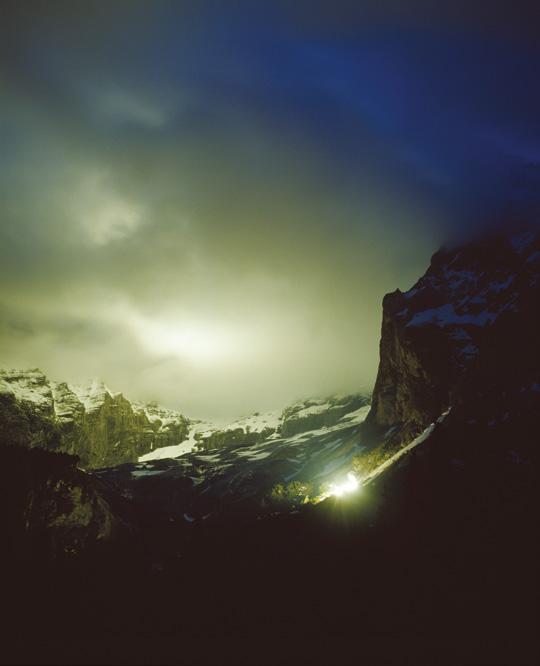
Aberdeen Art Gallery & Museums
Rachel Maclean
The Lion and The Unicorn (2012)
Digital video
11.29 min
Edition 1/10
The Massacre (2013)
Archival inkjet prints
91.5 x 61cm
Edition 2/10
Highland Romance (2013)
Archival inkjet prints
91.5 x 61cm
Edition 2/10
St George and the Monster (2013)
Archival inkjet prints
91.5 x 61cm
Edition 2/10
The Baptism of Clyde (2013)
Archival inkjet prints
91.5 x 61cm
Edition 2/10
Rachel Maclean (b. 1987, Edinburgh, UK) lives and works in Glasgow. Her work has been shown at Glasgow Film Festival (2014), Wysing Arts Centre, Cambridge (2013) and Collective Gallery, Edinburgh (2013). Solo exhibitions include Zabludowicz Collection, London (2014) and The Centre for Contemporary Arts, Glasgow (2014).
Over the past few years, Maclean’s highly distinctive visual output has enjoyed the acclaim of artists, curators and critics across the UK. Through masquerade and performance, her work engages with notions of identity, online media and memes, and takes the form of video, printmaking and installation. In her videos, Maclean ventriloquises various cultural types, from pop-culture characters to mythical figures and politicians.
A central strand of Maclean’s work addresses the ideals of Scotland and Scottishness and their reality as portrayed by contemporary mass media. The Lion and the Unicorn is a short film in which three archetypal characters debate points of view on nationalism, trade and finance, natural resources and politics. They each use Scotland’s history to expound their arguments, yet their views cannot be reconciled. Maclean uses costumes, makeup and digital retouching to embody each of these Scottish national stereotypes. The video uses audio from television broadcasts, dubbed over Maclean’s performances: the Lion is given Jeremy Paxman’s voice and the Unicorn Alex Salmond’s, as they squabble over the future of Scottish governance. A series of four prints also presented by the Contemporary Art Society echoes the video’s engagement with themes of Scottishness in Maclean’s signature maximalist style.
Presented by the Contemporary Art Society, 2014
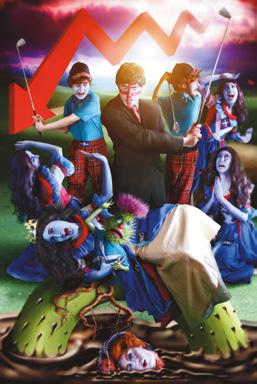


Jess Flood-Paddock
Snacks 4 (2011)
Plaster, acrylic paint, canvas
35 x 20 x 20cm (approximately)
London Oyster Shells (2012)
Jesmonite, paint
46 x 35 x 17cm
Jess Flood-Paddock (b. 1977, London, UK) is a sculptor based in London. In recent years, she has enjoyed a growing national and international reputation thanks to her exuberant sculptural practice which engages with elements from popular culture including food, design and literature. Recent solo exhibitions include Tate Britain, London (2012) and the Hayward Gallery, London (2010).
Flood-Paddock’s work seeks to expose the emotional dimensions of inert objects and what they reveal about human interaction. With forays into processes such as photography, video, scenic painting and ceramics, her works are sometimes produced using humble materials such as plywood, plaster, paper and cloth. She creates oversized but decidedly un-monumental versions of everyday objects, which can disturb the references that ground us in the everyday and rock our expectations of material reality.
Snacks 4 is from a series of works related to wasabi peanuts and is made of plaster, canvas and acrylic paint. London Oyster Shells recalls Flood-Paddock’s large-scale installation Gangsta’s Paradise, presented in 2010 at the Hayward Gallery, which made connections between Lewis-Carroll’s poem
The Walrus and the Carpenter, the film
The Truman Show (1998) and the cultural specificity of moral questions related to the consumption of oysters. This work exemplifies Flood-Paddock’s tendency to scale objects up to mammoth proportions, troubling expectations attached to scale, weight and materiality.
This is the first acquisition of Flood-Paddock’s work by a public collection in the UK.
Presented by the Contemporary Art Society with the support of Birmingham Museums Trust, 2014

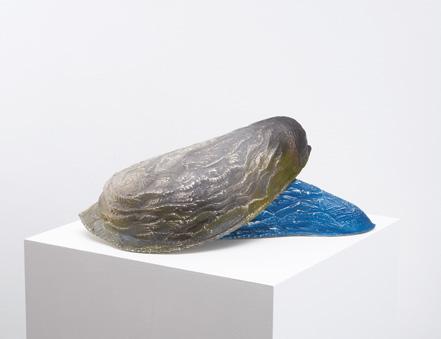
Jeff Keen
O Here Comes the Seafaring Man (1950)
Collage, ink and crayon
46 x 59cm
Jeff Keen (1942-2012, Trowbridge, UK) was an experimental film-maker, poet and artist. His work has not had the recognition it deserves, and has only recently been purchased by Tate following the 2012 retrospective Shoot the Wrx at Brighton Museum & Art Gallery. O Here Comes the Seafaring Man, shown in this exhibition, is an evocative and allusively cinematic example of Keen’s early collage-making work. It was through collage that Keen found a crucial stepping-stone between art and film in the 1950s. O Here Comes the Seafaring Man shows a sailor in search of the carnivalesque pleasures on offer in a seaside town. Keen combines a surrealist drawing style (typical of his early drawings from the 1940s) with cut-outs from magazines to create a playful and humorous depiction of human desire.
Keen spent most of his artistic career in Brighton. The collage connects to Brighton Museum’s existing Surrealist works, to their depictions of Brighton as a sea-side resort, and to Brighton Museum’s early cinema and optical toys collection. The acquisition of Jeff Keen’s work for Brighton Museum will enable the gallery’s curators to conceive of new areas of collecting within Post-War British art, the international avant-garde, and more contemporary multi-media practices.
Brighton Museum & Art Gallery has a small but growing collection of modern and contemporary works. It is particularly strong in Surrealist design with works such as Salvador Dali’s iconic Mae West sofas. One of the more hidden strengths at Brighton Museum & Art Gallery is the social history collection of ephemera relating to the Brighton experimental film-makers of the early twentieth century.
Presented by the Contemporary Art Society, 2013

Sarah Dobai
Twenty Second Hold (2012)
Digital Film
9 minutes 2 seconds
Edition 1/3
Sarah Dobai (b.1965, Kingston upon Thames, UK) works across photography, film and video and is interested in the creative process of image-making in cinema and the mass media. In her words, ‘the dynamics of space, place and the human subject as understood through our own intimate experience and the images of collective experiences represented on TV, cinema and in literature.’
From 2004-06 Dobai undertook a residency with Delfina Foundation where she chose Parisian shopping malls in the margins of the city as her object of study. Inspired by Walter Benjamin’s Arcades Project, Dobai used this space to examine how the performance of our public selves and our real selves is always mediated by our identification with mass media imagery. She essayed this idea in the Studio/Location photographs series posing models of all ages in sets reminiscent of the architecture of the malls. The film that followed, Twenty Second Hold, traced the tensions between the young models on location shoots, juxtaposing the professional performances (the titular twenty-second pause) of a moment of photographed intimacy and the relaxed gestures in-between in a double performance.
In recent years, as part of the Art Fund International scheme, Bristol Museum built a major collection of works that explore the notion of the modern metropolis, including artists such as Ai Weiwei, Omer Fast, Shilpa Gupta, Walid Raad, and Imran Qureshi. It is within this thematic context that Sarah Dobai’s film will enter the collection in conjunction with two photographs from the same series acquired by the Friends of Bristol Museum and Art Gallery, Emily and Emmanuel (2008/9) and La Scène (2009).
Presented by the Contemporary Art Society, 2013

David Shrigley
Untitled (2009)
Ink on paper
29.7 x 21cm
Untitled (2010)
Ink on paper
42 x 29.7cm
Untitled (2009)
Ink on paper
29.7 x 21cm
David Shrigley (b. 1968, Macclesfield, UK) has a prolific drawing practice. For him, ‘drawing is its own reward; it’s not a means to an end. Drawing was fun when I was at infant school, and it’s fun now.’ In 2013, Shrigley was nominated for the Turner Prize and his work has been selected for the Fourth Plinth commission in 2016. Recent solo exhibitions include Cornerhouse, Manchester (2013) and the Hayward Gallery, London (2012).
In 2012-13, Bradford Museums & Galleries worked with Shrigley on an exhibition of works on paper at Bradford 1 Gallery. This extremely popular show was accompanied by an illustrated talk by Shrigley, which was the most successful and oversubscribed to date.
The Contemporary Art Society gift of three drawings by Shrigley makes the most of the success of Cartwright Hall Art Gallery’s existing relationship with the artist. It also reinforces the collection’s particular strength in the area of works on paper. Cartwright Hall’s collection was initially shaped by gifts from local textile manufacturers who were particularly interested in contemporary British and French artists. Many of the drawings in the collection were acquired in the 1920s and 1930s when there was a policy of collecting drawings by British artists. Cartwright Hall is extending this early remit by acquiring a selection of three of Shrigley’s drawings: a humorous drawing, a text-based work and a more figurative piece.
Presented by the Contemporary Art Society, 2014
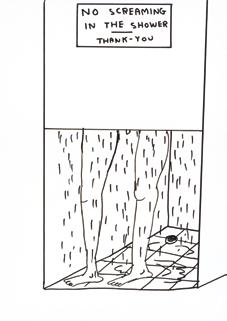
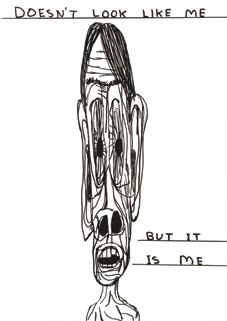

Alan Kane
Home-works 1 (2014)
Garden sculpture, bricks, mortar, concrete, steel, household paint
230 x 60 x 60cm
Home-works 2 (2014)
Garden sculpture, bricks, mortar, concrete, steel, household paint
230 x 60 x 60cm
Alan Kane (b. 1961, Nottingham, UK) is based in London. Past projects include solo exhibitions at galleries including the Whitechapel Gallery, London (2011), Turner Contemporary, Margate (2006), and the Showroom, London (2000) and Life Class / Today’s News, the Artangel/Jerwood Open commission for Channel 4.
Kane’s work often takes the form of sculptures incorporating found or readymade components. It plays with the entrenched systems and values of the art world, in particular the perceived hierarchies that govern different art forms.
Home-works 1 and Home-works 2 consist of reproductions of classical sculptures placed on brightly coloured painted brick plinths. They reference the neoclassical marble sculpture held by the Usher Gallery but are made of more modest materials including bricks, mortar and garden sculptures. This highlights the subjective nature of their status as fine art objects. For some, they sit uncomfortably within a fine art institution, and for others they represent the democratisation of the Usher’s collection. The illustration opposite is an artist’s sketch for the work, which will be made on site during summer 2014.
In 2010 the Usher merged with The Collection and now has an active contemporary art programme. Kane’s works will be sited in an important open-air location joining the two sites. One of the strengths of their joint collection is a group of neoclassical sculptures by Joseph Nollekens, John Gibson and John Bacon which Kane’s works specifically relate to.
Presented by the Contemporary Art Society, 2014

Imran Qureshi
This Leprous Brightness (2011)
Opaque watercolour on wasli paper
26 x 34cm
Imran Qureshi (b.1972, Hyderabad, Pakistan) has become one of the leading figures in developing the ‘Contemporary Miniature’ aesthetic. His practice combines traditional motifs, symbolism, and ornamentation from the Moghul tradition with conceptual thought and contemporary abstract painting. Imran Qureshi’s work is strongly marked by the reality that surrounds him in Pakistan and current social themes, as well as the confrontation with global concerns, such as the relationship between the western and Muslim world. Religion, gender roles, terrorism, and the politics of war form a subtle political discourse in his works of art.
This Leprous Brightness represents the development of his practice from traditionally worked, small-format miniature paintings. It belongs to a series that resulted from witnessing the aftermath of a terrorist explosion in Lahore. Qureshi’s bloody footprint has a visceral power in itself but on closer inspection leaves are growing across the feet, representing life emerging from the devastation while referring to his background and training as a miniature artist.
Gallery Oldham identified contemporary art from South Asia, particularly Pakistan and Bangladesh, as a priority collecting area ten years ago. This work from Imran Qureshi, who is at the forefront of art practice in Pakistan today, allows the collection to extend this ambition.
Presented by the Contemporary Art Society, 2013

Rut Blees Luxemburg
The Kiss (2003)
140 x 180cm
Hand-printed photographic C-print, mounted on aluminium Artist Print 1/2
Rut Blees Luxemburg (b. 1967, Leimen, Germany) lives and works in London. Her work has been shown internationally in exhibitions and festivals including Rencontres D’Arles (2011) and at Tate Liverpool (2003), and is included in public collections in Belgium, France, Germany, Spain and the UK.
Blees Luxemburg has a well-established practice of urban photography, with which she investigates the metropolitan landscape and the ways in which the city affects the human condition, as well as its relationship with literature and music. With a sense of play and fluidity, her works suggest new ways of navigating the city, and explore the possibilities of rediscovery, beauty and poetry, which exist beneath the harsh surface of the built-up environment.
In 2003, Glynn Vivian Art Gallery worked with Blees Luxemburg on an exhibition entitled Ffolly, which included a group of newly commissioned works shot in Swansea. The Kiss is part of this group of works, as is Swansea sur mer, which the artist gifted to the Glynn Vivian Art Gallery at the time of this acquisition. Both works have a particularly powerful resonance for the people of Swansea because of their depiction of familiar and evocative elements of Swansea’s identity.
The Kiss is an abstract image in which gum stuck to the pavement in Swansea undergoes a poetic, alchemical transformation into gold, whilst Swansea sur mer depicts the beach through a cluster of trees, an instantly recognisable landmark for local residents.
Presented by the Contemporary Art Society with the support of the Association of Friends of the Glynn Vivian Art Gallery, 2014
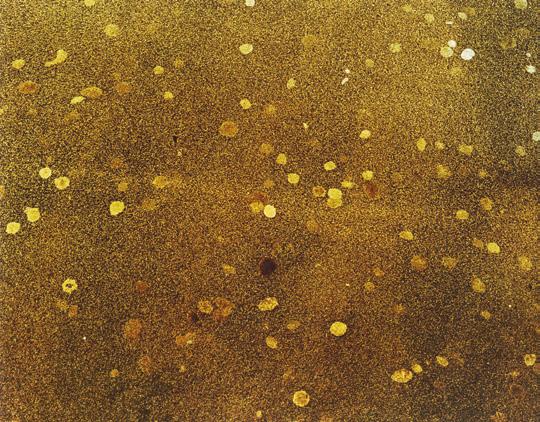
Imperial War Museum, London and Wolverhampton Art Gallery
Larissa Sansour
Nation Estate (2012)
HD video
9 minutes
Edition 2/6
Larissa Sansour (b. 1973, Jerusalem) studied Fine Art in Copenhagen, London and New York. Her work has been included in biennials in Busan (2008), Istanbul (2009 and 2011) and Liverpool (2010). Recent solo shows include the Centre for Photography, Copenhagen (2012), DEPO, Istanbul (2011) and Kulturhuset, Stockholm (2010).
Sansour’s interdisciplinary practice engages with contemporary geopolitics and cultural identity in relation to the unstable situation in the Middle East through mediums including video, photography and installation.
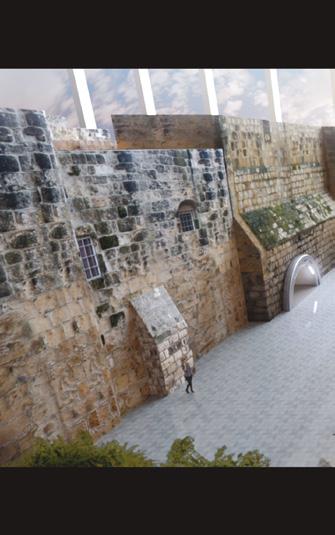
Nation Estate is a nine minute high definition video exploring ideas of architecture, border crossings and restrictions, access to resources, and community and identity evidenced in shared histories, built heritage and food culture. It addresses the theme of boundaries and movement and the restrictions placed on the everyday lives of Palestinians, proposing an imaginative — if dystopian — solution to the current political deadlock: a single high-rise building containing a Palestinian ‘homeland’. This fantastical solution to the Israel/Palestine conflict is a disturbing vision in which the inhabitants’ local areas are artificially reconstructed inside the towering
structure and the water supply is sponsored by NGOs. Nation Estate is Sansour’s most ambitious and sophisticated film to date.

Over the past two years the Imperial War Museum and Wolverhampton Art Gallery have partnered to research and collect a body of work focussing on the Arab/Israeli conflict, which included a visit to Palestine in April 2013. Sansour’s work will form a key part of this important and challenging group of works.
Presented by the Contemporary Art Society with the support of the Imperial War Museum, London and Wolverhampton Art Gallery, 2014
Becky Beasley
Figure (Part 3) (2008)
Selenium toned gelatin silver print, brown acrylic glass, wooden artist’s frame
102.5 x 154.5cm, framed 117 x 164.3cm Edition 2/2

Becky Beasley (b. 1975, Portsmouth, UK) is based in St. Leonards on Sea, East Sussex. She has had recent solo exhibitions at the South London Gallery (2014), Leeds City Art Gallery (2013) and Spike Island, Bristol (2012). In 2009, she was shortlisted for the Max Mara Art Prize for Women.
Beasley’s work is predominantly concerned with the relationships between objects and photography. Its form oscillates between object-based sculpture and its photographic representation. In practice, her work often transforms a sculpture to a photograph, after which another sculpture might be made. Beasley’s work highlights ambiguities in the relationships between images and objects and, later, between artwork and viewer.
Figure (Part 3) is from a series of works depicting constructed objects which possess

a profound ambiguity: they seem to suggest a ‘use’, which is then denied by depicting a type of plank used in construction work, but quite useless as a plank. The work can be linked to Beasley’s time spent in Athens in 2004, when, she says, she ‘became interested in temporary structures which appeared and disappeared daily in a city under rapid reconstruction and modernisation. I began to think of buildings as a potential still life.’
The close ties between Leeds Art Gallery and The Henry Moore Institute, which manages the sculpture collection and archive of Leeds Museums and Galleries, will ensure that this work benefits from the world-class displays organised by these two institutions and the scholarship fostered by the Institute.
Presented by the Contemporary Art Society with the support of Leeds Art Gallery, 2014
Des Hughes
Installation
180 x 170 x 25cm
Through his sculptures, Des Hughes (b. 1970, Birmingham, UK) reconfigures our rapport with the everyday by staging banal readymade objects next to handcrafted replicas of commodities and three-dimensional caricatures of familiar things, creating a world that is surreal and comic, with a particular form of deadpan Britishness.
In a Brown Study is a framed screen assemblage that explores the nature of collecting and the relationship between juxtaposed objects. Its form is inspired by the ‘framed screen’ at 2 Willow Road, Hampstead, the home of the Modernist architect Ernö Goldfinger which displayed a constantly changing collection of family pictures and artefacts. It also echoes the screen used by Surrealists as a device for ‘framing openings’, a democratic space for insinuation and emotional relationships between objects that are introduced.
The work was launched into the collection through a display of works selected by Hughes that included The Artist’s Mother (1949) by Alberto Giacometti, Doves (1927) by Barbara Hepworth, 16th century drawings and 20th century landscapes, portraits and still-life paintings. Manchester Art Gallery has impressive historic and modern collections, the latter of which is particularly strong in early 20th century British art including Paul Nash, Stanley Spencer, Wyndham Lewis and Henry Moore.
Presented by the Contemporary Art Society with support from the V&A Purchase Grant Fund and the Friends of Manchester City Galleries, 2012

Ruth Ewan
Nae Sums 1911 (2011)
Wood (cut from reclaimed Dundee school desks)
Dimensions varied –
Dreadnoughts (2010)
Four letterpress posters
59.5 x 42cm
Ruth Ewan (b. 1980, Aberdeen, UK) has exhibited at New Museum, New York (2009), Folkestone Triennial (2011) and Tate Modern (2010). Her practice explores the histories of protest and the consequences that particular socio-political issues or events have had on local groups. Through her sculptures, performances, and prints Ewan highlights narratives of social resistance and brings them back into the public conscience.
Nae Sums was created for Ewan’s first major solo show in the UK, Brank & Heckle, at Dundee Contemporary Arts (2011). Nae Sums is an imagined slogan of the 1911 city school strikes made from reclaimed school desks, archive material and drawings made with local young people of activist, poet and musician Mary Brooksbank and a stunted version of Dundee’s own Liberty Tree, once planted in support of the French Revolution.
The woodblock, letterpress prints, purchased to accompany Nae Sums were produced following her Dreadnoughts project at Chisenhale Gallery, London (2010). Borrowing its title from activist Sylvia Pankhurst’s radical newspaper, Workers’ Dreadnought, for which she was imprisoned for sedition, Dreadnoughts comprised a series of walking tours rooted in an historical struggle in the local area. The resulting prints take slogans or ideas from political ideologies in east London from the 1830s to the 1980s.
Dundee Art Galleries and Museums’ fine art collection is diverse and wide-ranging with historic oil paintings, watercolours, drawings, prints, sculpture, and new media and is renowned as the first collection of fine art photography in Scotland. Recent acquisitions for the collection include work by Catherine Yass, Graham Fagan and John Stezaker
Presented by the Contemporary Art Society, 2012


Plath Winged x 2 (2010)
watercolour on paper
31 x 23cm
Sarah Pickstone
KM’s Moth (Red Underwing) (2014)
oil and acrylic on gessoed wood panel
72 x 58cm
Study for Sylvia (2010)
watercolour on paper
51 x 36cm
Study for Stevie Smith and the Willow (2011)
watercolour on paper
51 x 36cm
Sarah Pickstone (b.1965, Manchester, UK) has exhibited widely both nationally and internationally. She won the 2012 John Moores Painting Prize for her painting Stevie Smith and the Willow. Her paintings can be characterised by their lightness and openness and their fluid gesture and feminine pallet. She works in series, most recently investigating the influence of memory, imagination and the natural landscape on female writers.
Pickstone’s ghostly images of Katherine Mansfield and Sylvia Plath depicted in the works selected for Mercer Art Gallery conjure up the sense of the writers’ work — Mansfield’s short stories and Plath’s poetry — along with the tragic brevity of both lives: Mansfield died of tuberculosis during the First World War aged 34 and Sylvia Plath killed herself in 1963 when she was 30. Stevie Smith, the focus of one of the drawings, illustrated her poems with little sketches that are echoed in Pickstone’s homage.
The Mercer’s collection is surprisingly strong on works by women artists such as Dame Laura Knight’s The Rehearsal from the 1930s and, more recently, work by Eileen Agar, Eileen Cooper, Tacita Dean, and Rose Garrard. Sarah Pickstone’s works will make a significant contribution to this expanding focus.
Presented by the Contemporary Art Society, 2014
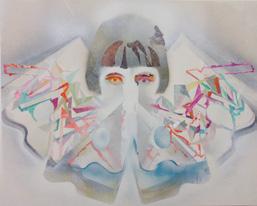
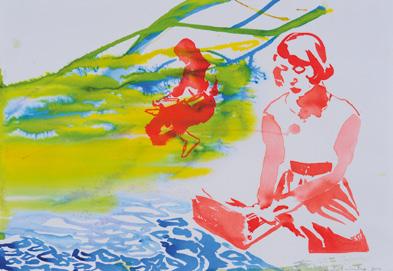

Teresa Margolles
Papeles de la morgue [#9] (2003)
Water drawing on fabriano paper with water that has been used to wash dead bodies after autopsy
60 x 80.5cm
Teresa Margolles (b. 1963, Culiacan, Sinaloa, Mexico) lives and works in Mexico City. Her work has been shown in numerous international museums and biennials. Recent solo exhibitions include Migros Museum, Zurich, Switzerland (2014), Glasgow Sculpture Studios (2012) and Los Angeles County Museum of Art (2010). In 2009, she represented Mexico at the Venice Biennale and in 2012 she won the fifth Artes Mundi prize.
Margolles’ work focuses on the rituals and systems at play in the management of death. It turns an unflinching gaze at the realities of death and frequently uses the by-products of forensic processes, such as water used to wash dead bodies in morgues. These materials are used to produce sculptures, installations and performances that provide a poignant and visceral comment on her country’s attitudes towards death and the extreme violence perpetrated in areas such as Northern Mexico, where cartel wars and murders of women are endemic.
For the series of Papeles de la morgue, Margolles pulled a sheet of watercolour paper slowly through water previously used to wash corpses after autopsy. Organic substances such as blood, fat and hair which made their way to the body’s surface in the course of the examination cling to the absorbent paper. By immersing the paper in the water used to wash a body, the artist has created abstract and extremely moving anonymous portraits of the dead.
Presented by the Contemporary Art Society, 2014

Laura Lancaster
Untitled (2013)
Oil on Linen
50 x 40cm
Untitled (2013)
Oil on Linen
40 x 50cm
Untitled (2013)
Oil on Linen
60 x 50cm
Laura Lancaster (b. 1979, Hartlepool, UK) lives and works in Newcastle upon Tyne. Her paintings have been shown in solo exhibitions in the UK including at the DLI Museum, Durham (2011) and the Laing Art Gallery, Newcastle (2013-14).
Lancaster’s paintings take as their source and subject photographs the artist finds at flea markets and in charity shops. The artist considers this process of re-using found imagery as a form of rescue, lending contextless images new life in her works. Lancaster sees photographs that were originally taken to fix a moment in time as eventually set adrift from their original context. In this process, they gain an abstract quality, disconnected from a particular meaningful context even though they are full of visual clues and information. The intention behind the snapshots Lancaster finds has become divorced from the picture’s surviving material reality.
The three works acquired for New Art Gallery Walsall exemplify Lancaster’s expressive use of paint, with which she introduces movement into the inert material with an evident enjoyment. Her works often tease at the conventions of traditional painting, in particular portraiture. Her confident handling of paint and loose brushstrokes add up to evocative portraits which sometimes recall the work of canonical British painters such as Frank Auerbach or Lucian Freud, also represented in The New Art Gallery’s collections.
Presented by the Contemporary Art Society, 2014


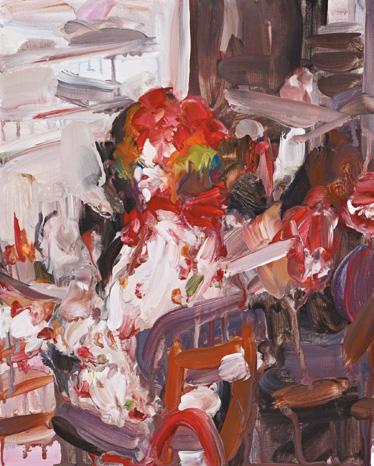
Camilla Løw
Cinematic (2014)
Aluminium, enamel paint, cord
60 x 60 x 20cm — height variable
Camilla Løw (b. 1976, Oslo, Norway) lives and works in Oslo, Norway. Her sculptures have been presented in solo exhibitions at institutions including The National Museum of Art, Architecture and Design, Oslo (2012), New Art Centre, Roche Court, Salisbury (2010), and Bergen Kunsthall No.5 (2008).
Using industrial materials such as concrete and painted steel, Løw describes her works as ‘an investigation into what might be seen as traditional sculptural or architectonic concerns with form, space, rhythm, tension, balance and the properties of materials’.
Cinematic is the second work by Løw to enter The Pier Arts Centre’s collections. Its circular form and construction as a mobile, along with its title, which alludes to moving images, offer a playful exploration of form and its dynamic potential.
Circles and oval forms are a strong theme within The Pier Arts Centre’s collection, especially in the work they hold by Ben Nicholson, Barbara Hepworth and Peter Lanyon. The delineated and formal structure of Cinematic will allow connections to be made between key paintings and sculptures within their core Collection. This conversation between works that represent a historic high point in British Modernism and the concerns of artists working today is central to the way the Pier Collection has developed over the last ten years.
The work will also add to the Pier’s collection of Scandinavian art and will significantly strengthen the group of works by contemporary women artists that have been built up around works by Barbara Hepworth
Presented by the Contemporary Art Society, 2014

Lynette Yiadom-Boakye
Oil on canvas
60 x 55cm
Lynette Yiadom-Boakye (b. 1977, London, UK) studied at Falmouth College of Art and now lives and works in London. Her figurative paintings are drawn from her own fictitious set of characters and allude to traditions of European portraiture. YiadomBoakye’s paintings engage with the history and genre of portraiture, at once referencing and entirely evading the traditions of canonical portraiture. To Tell Them Where It’s Got To, exhibited at The Arsenale, Venice Biennale (2013) is a key work, showing the transition in Yiadom-Boakye’s practice from the confrontational pose to the figure turned away from the viewer.
The majority of the collection at Plymouth City Museum & Art Gallery is works by English artists from the 19th and 20th centuries. As the birthplace of Sir Joshua Reynolds, ‘traditional’ portraiture forms a rich seam running through their collection. The gallery also holds paintings by the Camden Town Group and Walter Sickert, a key member of the group, is a particular influence for Yiadom-Boakye. She has said she admires his ability to describe a lot with very little, that ‘his markmaking often appears sparse and rough, graduating the tone from dark to light, working from the darkness at the back of the painting forwards into the light. Dark brown staining and dull dirty pinks become radiant.’
Presented by the Contemporary Art Society with the additional support of Corvi-Mora, London, 2013

Elizabeth McAlpine
Ends (Sprayed Sound) (2013)
C-type print
85 x 120cm
Elizabeth McAlpine (b. 1973, London, UK) works in photography, sculpture and moving image, exploring and experimenting with analogue and digital photographic techniques. Her work has been shown in solo exhibitions at Reg Vardy Gallery, Sunderland (2012), Eastside Projects, Birmingham (2010) and in group exhibitions including Everyday Epiphanies, Photography and Daily Life Since 1969 at The Metropolitan Museum of Art, New York (2013) and UnSpooling — Artist & Cinema at Cornerhouse, Manchester (2010).
McAlpine produced the first works in her Ends series in late 2013. The series transforms the discarded materials of film production into new works. ‘Ends’ are the last frames of a reel of 35mm moving image film stock which have been exposed to incidental light in the darkroom developing process. McAlpine has cut, collaged and layered these sections of film to create abstract compositions and has used these to produce photographic prints which amplify the traces of the human hand in the surface texture of scratches and dust.
When embarking on this acquisition, Rugby Art Gallery & Museum expressed a desire to establish a photography collection which could resonate with other parts of their collection, in particular The Trilogy (2005-10), an important work by Lindsay Seers, also acquired through the Contemporary Art Society. McAlpine’s Ends (Sprayed Sound) is the foundational work for this photographic branch of Rugby’s collection.
Presented by the Contemporary Art Society with the support of Rugby Art Gallery & Museum, 2014

Ed Atkins
The Trick Brain (2012-13)
Single channel HD projection with 5.1
Surround Sound
16 minutes 15 seconds
Edition 3 of 6 + 2AP
Ed Atkins (b. 1982, Oxford, UK) practice explores digital media’s apparent immateriality in relation to its possibilities for precise representations of the physical and corporeal world through high definition video, sound, writing and drawing. He graduated from the Slade School of Fine Art in 2009 and has since received the Jerwood Projects / Film and Video Umbrella Award (2012) and been nominated for the Jarman Award (2013).
Atkins’ film The Trick Brain features archival footage from the DVD that accompanied the infamous auction of the André Breton estate in 2003 from which the Scottish National Gallery of Modern Art bought a number of items. The film meditates on the immediate effects of the sale and distribution of Breton’s collection and its wider implications for historical artefacts.
The gallery is home to Scotland’s outstanding national collection of modern and contemporary art. Its two buildings, Modern One and Modern Two, house work from the beginning of the 20th century including superb holdings of expressionist and modern British and Scottish art, an outstanding collection of international post-war work and the most important and extensive collection of modern Scottish Art.
The gallery’s Surrealist collection is one of the largest anywhere in the world. It also holds a substantial number of prints, archival material, periodicals, books, letters and other important publications in the gallery’s dedicated Keiller Library.
Presented by the Contemporary Art Society with support from Scottish National Gallery of Modern Art, 2013


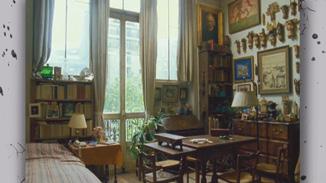
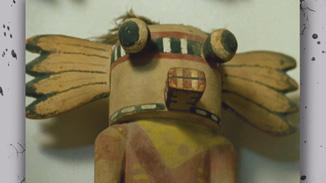
Phoebe Unwin
Concrete Ball (2012)
Acrylic, powder pastel and acrylic
pumice gel on canvas
70.3 x 80.5cm
Phoebe Unwin (b. 1979, Cambridge, UK) trained at Newcastle University and the Slade School of Fine Art. She has developed a unique practice that relies on the continual collecting of ideas, scraps of the material world, images, textures and memories of transient life experiences, compiled in sketch books. The content of these books are the inspiration and source material for making paintings.
Concrete Ball comes from a body of work focused on the material relationship to image within painting, where the material itself is part of the subject of the painting. The title describes both the physicality of the painting and also what is pictured. In her words, ‘I was interested in capturing a sensation of conflict: between lightness and heaviness, stillness and movement.’ The concrete-like effect is made with an artists’ acrylic medium called pumice gel. The washes are a combination of acrylic and poster pastel. As well as a contrast through texture the painting tracks physical movement giving the sensation and visual description of the ball moving across the picture plane.
The core of Southampton City Art Gallery’s collection is British 20th century and contemporary painting and sculpture.
Presented by the Contemporary Art Society in honour of Paul Hobson (Director, Contemporary Art Society, 2007-2013), 2013

Magnus Quaife
Untitled (Miss Iceland) (2010)
Watercolour on paper 50 x 70cm
From the series 1968 and Other Myths (2010-12) –
Untitled (Ben) (2010)
Watercolour on paper 50 x 70cm
From the series 1968 and Other Myths (2010-12)
Untitled (Prague Tank) (2010)
Watercolour on paper 50 x 70cm
From the series 1968 and Other Myths (2010-12)
Magnus Quaife (b. 1975, Nottingham, UK) lives and works in Manchester. His work has been shown in solo exhibitions as part of the Liverpool Biennial (2010) and at The International 3, Manchester (2004 and 2008). His practice involves an exploration of the significance and circulation of images and cultural artefacts through painting and curating.
As the 40th anniversary of the epoch-making events of May 1968 approached, Quaife embarked on a series of over 30 paintings which would take him three years to complete. The works in 1968 and Other Myths depict recognisable and iconic images from the 1968 student revolts as well as tangentially related ones, found through online research or via other unsystematic channels. The series has a relationship with history painting, although Quaife’s chosen medium of watercolour is unusual for such a potentially charged subject: it suggests the evanescence of the historical moment rather its memorialising.
Swindon Museum and Art Gallery’s collection focuses on major artists and movements of 20th and 21st century British art. The Contemporary Art Society has presented Swindon Museum and Art Gallery with three watercolour paintings from the series 1968 and Other Myths. Quaife’s concerns with subverting straightforward representation, reproduction and the relationship between source and artwork provide the potential for an interesting dialogue with work by Richard Hamilton, John Walker and Richard Long in Swindon’s collection.
Presented by the Contemporary Art Society, 2014


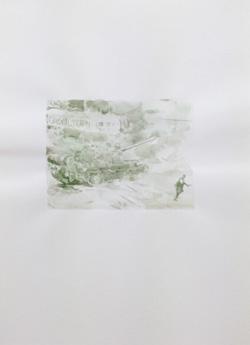
370 x 300cm
The Contemporary Art Society is delighted to present Tate with One Painting (1999) an exemplary early work by Angela de la Cruz (b. 1965, La Coruña, Spain). De la Cruz moved to London in 1989 and studied at Goldsmiths College and the Slade School of Art. In 2012 De la Cruz was short-listed for the Turner Prize in recognition of her survey exhibition at Camden Arts Centre in 2010.
One Painting is a work from de la Cruz’s early career when the artist was establishing the characteristic approach to painting for which she has become recognised. As Tate continues to seek to represent mid-career artists who came to the fore in the 1990s, this key work offers an opportunity to strengthen holdings in this area by beginning de la Cruz’s representation within Tate’s Collection. One Painting is a large monochromatic canvas with an off-white surface. Hanging from the corner of the gallery at close proximity to the floor, the painting’s visible stretcher bars have been roughly broken on the left side and part of the canvas torn vertically. The work appears to have been crushed as its broken parts tilt tentatively from the corner of the gallery. One Painting belongs to a defining body of work which de la Cruz referred to as Everyday Paintings made between 1995 and 1999. Beginning life as rectilinear abstract paintings, these canvases were then subjected by the artist to unusual and often violent physical distortions.
One Painting was originally purchased by Dr Thomas Frangenberg, private collector and History of Art lecturer at the University of Leicester, through the Contemporary Art Society’s Distribution Scheme in 2001. The work was included in Contemporary Art Society’s exhibition ShowCASe at the South London Gallery in 2004, which went on to tour to Talbot Rice Gallery and City Art Centre, Edinburgh in 2005.
Presented by the Contemporary Art Society, 2013

Uriel Orlow
Installation
Dimensions variable
Uriel Orlow (b. 1973, Zurich, Switzerland) is based in London. Recent exhibitions include Manifesta 9 (2012), the 54th Venice Bienniale (2011) and 8th Mercosul Biennial in Brazil (2011). His work has been presented in solo exhibitions at institutions including Spike Island, Bristol (2013), Prefix Institute of Contemporary Art, Toronto (2012) and ACAF Alexandria, Egypt (2011).
Orlow is known for his modular multi-media installations that take specific locations and events as starting points and combine archival research with evocative photography, moving image and sound.
The Short and the Long of It is a multi-part installation based on an event that is mostly absent from official histories: the failed passage of 14 international cargo ships through the Suez Canal on 5 June 1967. Caught in the outbreak of the Six-Day War between Israel and Egypt, Jordan and Syria, it took eight years before the ships were able to leave the canal when it re-opened in 1975. While stranded, the Cold War political allegiances of the multi-national crews were dissolved and gave way to a form of communal survival and the establishment of a new social system.
Although the focus and starting point of this work is a real event, Orlow is more interested in providing interpreted insights rather than revealing the whole picture through a purely archival presentation. Using a range of media, including film, slide projections, and photography, he encourages the viewer to engage with the event through the layers and components of his work.
Presented by the Contemporary Art Society, funded by the V&A Purchase Grant Fund, Towner Eastbourne and the Contemporary Art Society, 2014

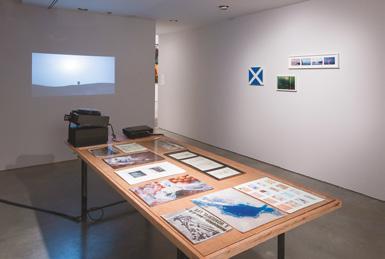
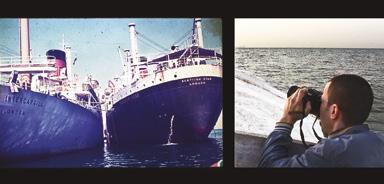
Clare Woods
Obscene Porridge (2012)
Oil on aluminium
70 x 70cm
Clare Woods (b.1970, Southampton, UK) lives and works in Herefordshire. Her paintings are based on photographs, taken at night, of undergrowth and vegetation, in desolate, contested or overlooked locations such as areas of scrub or deep woodland. Painstakingly transcribed using layers of enamel paint on aluminium, the resulting images are often ambiguous and disturbing, claustrophobic in their detail, and psychologically-charged.
Obscene Porridge is part of a body of work inspired by a letter Paul Nash wrote to his wife from the Passchendaele battlefield during the First World War. This particular painting is connected to a black-and-white photograph of the battlefield, which Paul Nash described in 1917, ‘The rain drives on, the stinking mud becomes more evilly yellow, the shell holes fill up with green-white water, the roads and tracks are covered in inches of slime’. The battlefield is infamous for the number of casualties and the mud which drowned soldiers and horses.
The painting complements Tullie House Museum & Art Gallery’s growing collection of landscapes which includes Keith Tyson’s Nature Painting, acquired in 2009. The museum also has an important collection of early watercolours and drawings by Paul Nash.
The modern collection was acquired through a purchase scheme (1933-1975) under the guidance of William Rothenstein. Key artists purchased were Stanley Spencer, Wyndham Lewis, Vanessa Bell and David Nash. Tullie House’s rural surroundings of the Lake District have made landscape a key feature of the collection, an area the curators are keen to focus on.
Presented by the Contemporary Art Society, 2013

Liverpool
Catherine Opie
The Gang (1990)
C-print
20.3 x 20.3cm
Edition 2/8
Catherine Opie (b. 1961, Sandusky, Ohio, United States) lives and works in Los Angeles, California. She is an internationally renowned photographer whose work in the areas of portraiture and landscape has been shown in exhibitions around the world. Recent solo shows include Long Beach Museum of Art, Long Beach, CA (2012), The Institute of Contemporary Art, Boston, MA (2011), Los Angeles County Museum of Art, Los Angeles, CA (2010) and the Guggenheim Museum, New York, NY (2008).
Opie came to critical attention in the early 1990s with a body of portraits of gay, lesbian and transgendered men and women drawn from her circle of fellow artists and intimates in Los Angeles and San Francisco. Working across a wide range of subjects, from LA freeways and house facades to high school football players, surfers in Malibu and ice fishers in Minneapolis, Opie explores notions of identity and community and the way they shape one another.
The Gang is part of Opie’s Girlfriends series, black-and-white square-format photographs she made in the 1980s and 90s documenting what she refers to as ‘these little moments of sexy desire and memory’. The Gang is one of the more light-hearted photographs in the series, and is an ideal work to address the Walker Art Gallery’s ambition to collect work related to lesbian, gay, bisexual and transgendered themes and communities.
Presented by the Contemporary Art Society with the support of the Walker Art Gallery, 2014

“Appreciation develops with understanding. As small scale collectors for over 20 years our understanding has been fed by public galleries and their exhibitions, by private galleries and their directors, by the artists we know, by the work of curators and the writings of critics and commentators. But at the heart of this didactic landscape has been the Contemporary Art Society and its diverse programmes, excellent staff and commitment to operate across the full length and breadth of the UK visual arts scene, inside and outside London. The Contemporary Art Society feeds our understanding—and appreciation!”
Penny Mason and Richard SykesAberdeen Art Gallery & Museums, Cheltenham Art Gallery & Museum, mima, Middlesbrough Institute of Modern Art
Chun Liao
For You (2012)
Thrown porcelain
Dimensions varied
Chun Liao (b. 1969, Taichung, Taiwan) lives and works in London. Her minimalistic, richly coloured porcelain pots fuse influences from East and West. Her work is held in numerous public collections, including the Victoria and Albert Museum and the Museum of Art and Design, New York.
Her vessels are a poetic metaphor of the passing of time. She writes ‘Porcelain is like white paper, with the silver and gold imprints marking the imperfections, writing a life in the pieces I make’.
In the installation For You, brightly coloured miniature bowls are juxtaposed against each other, often with minuscule traces of gold or silver fixed upon their surface. The porcelain is thrown and the edges and body manipulated to retain a sense of spontaneity and life. The assortment of colours, sizes, splashes and markings lend her vibrant installation a lively energy and although the individual parts are so different, they can be perfectly understood as a complete whole.
For You will tell different stories in each of its three homes: at mima it will sit within the collection of British Ceramic Art, demonstrating the enduring interest in Far Eastern influences in the British studio ceramic movement as well as contemporary uses of porcelain and strategies of accumulations and the grouping of pots. At Aberdeen and Cheltenham it will explore influences of Orientalism through collections of decorative arts and the Arts and Crafts movement.
Presented by the Contemporary Art Society Craft Acquisitions Scheme to Aberdeen Art Gallery & Museums and Cheltenham Art Gallery & Museum and mima, Middlesbrough, 2014

Luke Jerram
Glass Microbiology H1N1 Swine Flu (2011)
Glass
21cm diameter
Edition 5/5
Luke Jerram’s (b. 1974, Stroud, UK) practice includes sculpture, installation and live art projects. His works are held in museum collections around the world, including The Wellcome Collection, London and The Metropolitan Museum of Art, New York. Jerram’s complex glass works expose the tensions and complexities of scientific representation and how imagery is interpreted and consumed by the public.
Glass Microbiology is a body of transparent and colourless glassworks representing global viruses. They are created as an alternative representation to the artificially coloured imagery often seen in the media. In fact, viruses have no colour as they are smaller than the wavelength of light. By extracting the colour from the imagery and creating jewel-like beautiful sculptures in glass, a complex tension arises between the artworks’ beauty and the diseases they represent. The sculptures are made in collaboration with glassblowers Kim George, Brian Jones and Norman Veitch and are designed in consultation with virologists from the University of Bristol, using a combination of different scientific photographs and models. Photographs of Jerram’s glass artworks are now used widely in medical journals and are seen as useful representations of virology within the scientific community.
Luke Jerram exhibited his microbiology collection at the Usher Gallery in 2011. Agriculture and science have strong ties with Lincolnshire and Jerram’s glass viruses investigate questions around how viruses and disease are perceived in a predominantly rural county.
Presented by the Contemporary Art Society with support from the Friends of Lincoln Museums and Art Gallery and the LCC Purchase Fund, 2013
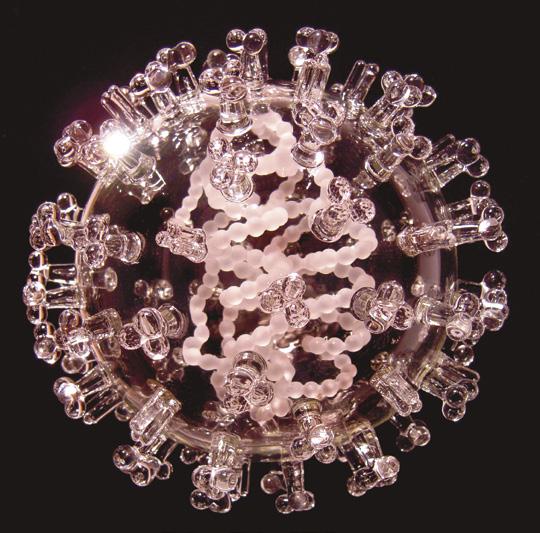
Alison Counsell
Wapenmap: Damflask, Dale Dike & Strines (2004)
Stainless steel wall mounted sculpture
60 x 60 x 15cm
Alison Counsell (b. 1961, Choma, Zambia) is a designer-maker based in Sheffield. She is a Senior Lecturer in Metalwork & Jewellery at Sheffield Hallam University. Her work
Wapenmap: Damflask, Dale Dike & Strines explores the connections between Sheffield’s industrial heritage and the city’s current topography. The stainless steel sculpture is based on Ordnance Survey maps produced from flat sheets of metal photo-etched with detailed geographical features. Lines are cut through the metal and tabs are pulled apart to raise the contours, creating the raised landscape which features four local water reservoirs. The reservoirs referenced in Counsell’s stainless steel piece were constructed in the mid-19th century to provide water for the people of Sheffield. At this point in the city’s history the population was expanding rapidly due to the development of the steel and cutlery industries.
Museum Sheffield’s collection represents artists from Sheffield and their longstanding tradition to work with stainless steel. Its designated Metalwork Collection currently holds over 700 steel pieces, the majority being traditional examples of cutlery and flatware. Counsell’s Wapenmap, Damflask, Dale Dike & Strines forms an engaging contemporary counterpoint to these more functional items, showing how this versatile material is being explored in new and diverse ways by the city’s artists. The acquisition also includes related design drawings and research support material that will form an intrinsic part of the displays, celebrating the legacy of the discovery of stainless steel in Sheffield.
Presented by the Contemporary Art Society, 2014

Claire Malet
Ridged Vessel (2014)
Recycled steel, 23ct red gold leaf, copper leaf
35cm x 28cm (approximate)
Claire Malet’s (b. 1965, Tunbridge Wells, UK) work is inspired by the rich textures, colours and shapes of natural forms and landscapes surrounding her studio in rural Herefordshire. Using non-precious and precious metals, she also draws inspiration directly from the natural qualities and characteristics of metal, enhancing the material’s complex surface textures and colour ranges. Her steel pieces explore the idea of transformation and perceived value. Malet is particularly inspired by vessel forms, both organic and man-made, as one of the most basic and universal objects used in daily life, playing vital roles at occasions of celebration and honour. She often employs tools designed for other purposes or uses traditional metalworking tools in new ways; for example cutting metal with a blowtorch, scratching into gold leaf or frazzling it with a torch. Her pieces that cross boundaries between fine and decorative art are exhibited and collected in the UK and internationally.
Ridged Vessel is part of an innovative body of work entitled Winter Sketch, a series of non-functional vessels characterised by lacy forms and striking colour.
Specifically made for Manchester Art Gallery, Ridged Vessel is worked from an old steel oil can which is ‘transformed’ into a ‘precious’ vessel. The exterior surface is raised by repeated hammering and annealing. The interior is covered with oxidised gold and copper leaf, bringing out fiery, autumnal colours.
Manchester City Galleries have a designated metalwork collection. The purchase of Ridged Vessel helps to keep the collection dynamic and strengthens the representation of women working in contemporary craft.
Presented through the Contemporary Art Society’s 2013 New Story of Craft Scheme with support from the Friends of Manchester City Galleries, 2014
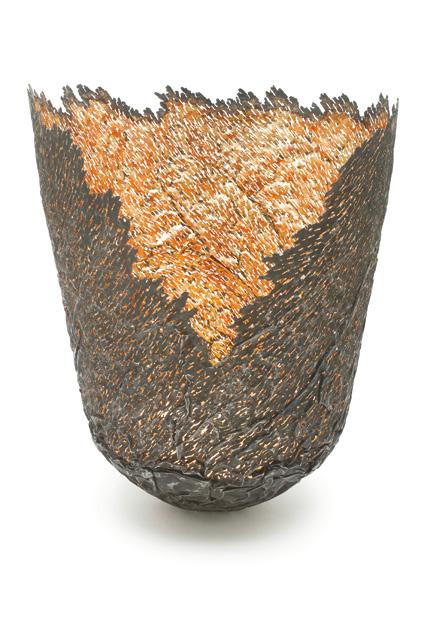
“The Contemporary Art Society’s contribution to our gallery has been invaluable. As well as assisting us to obtain contemporary work for the collection, the research trips and knowledge-sharing they provide have supported our curatorial work. By working so closely with the Contemporary Art Society over a number of years an environment has been created where there is no longer a distinction between regional and national galleries and programmes. You are just as likely to find new and innovative exhibitions, projects, commissions and acquisitions in regional galleries as in the capital. This is demonstrated by ongoing projects with Oliver Laric, Alan Kane and Emily Wardill which would not have been possible without the unfaltering work of the Contemporary Art Society.”
Ashley Gallant, Collections Access Officer (Contemporary Art), The Collection and Usher Gallery, LincolnThe Collection and Usher Gallery, Lincoln
Oliver Laric (b. 1981, Innsbruck, Austria) is based in Berlin. Encompassing objects, videos and sculptures, Laric’s work spans the liminal spaces between the past and the present, the authentic and the inauthentic, the original and its subsequent reflections and reconfigurations. His work explores the productive potential of the copy, the bootleg and the remix, and examine their role in the formation of both historic and contemporary image cultures. He has had recent solo exhibitions at MIT List Visual Arts Centre, Cambridge MA (2013) and Skulpturhalle Basel, Basel (2011).
Oliver Laric’s commission uses the latest digital scanning methods to render some of Lincoln’s most treasured and historic sculptures in highly-detailed 3D. More than 50 objects from The Collection and Usher Gallery have been scanned and put online at www.lincoln3dscans.co.uk. The 360° images, which can be downloaded for free without copyright restrictions, can be used by anyone including artists, researchers, schools and academics from around the world. Reincarnations of the initial data will continue to develop as it continuously travels and gets used and reused, developing into new projects in and outside of the art world.
The first scans include a 2nd century bust of Greek mythological figure Ariadne, Roman tombstones, medieval baptismal fonts, part of the pelvis bone from Anglo-Saxon remains, and an ancient mosaic. Laric plans to use a variety of the 3D images to create a unique collage sculpture for permanent display at The Collection, and he will add further scans to the site over time.
Presented by the Contemporary Art Society, 2012, through the Contemporary Art Society Annual Award, Funded by the Sfumato Foundation. Commissioned by The Collection and Usher Gallery, Lincoln
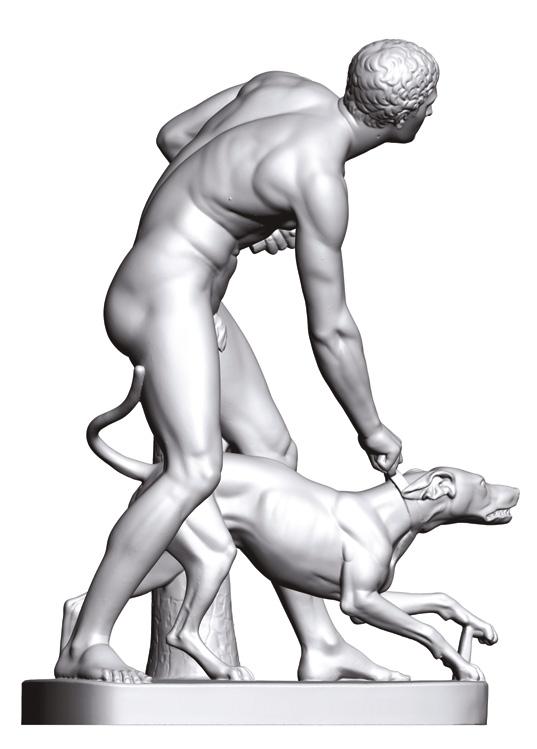
The Ashmolean Museum of Art and Archaeology, University of Oxford (in partnership with the Pitt Rivers Museum and the Ruskin School of Art)
Elizabeth Price (b. 1966, Bradford, UK) lives and works in London. Recent solo exhibitions and awards have included the Stedelijk Museum, Amsterdam (2013), Turner Prize (2012), Paul Hamlyn Award (2012), The Baltic, Gateshead (2012), Chisenhale Gallery, London (2011), Frieze Projects (2010) and Spike Island, Bristol (2009).
Informed by mainstream cinema and experimental film, Price’s work is concerned with the medium of digital video and its comparative ubiquity in today’s culture. Price’s commission will explore the archives and collections of the Ashmolean Museum and the Pitt Rivers Museum (which cares for Oxford’s holdings of anthropology and world archaeology), in particular the photographs of artefacts and documents created by curators and by anthropologists and archaeologists working in the field. The new work will disclose the differing taxonomic systems that have shaped and been employed by the two institutions while simultaneously engaging with the social and psychological implications of digital technologies.
The work, to comprise of a single-screen video, will present and narrate artefacts from the Ashmolean’s collection, with a focus on the female figure and the photographic and archival means of disclosing this figure over time. The commission will enable the Ashmolean Museum to add a significant moving image work to its existing holdings of contemporary art, to be premiered in Oxford upon completion, and will be a timely addition to the museum’s 330th anniversary celebrations in 2015.
Presented by the Contemporary Art Society, 2013, through the Contemporary Art Society Annual Award, funded by the Sfumato Foundation. Commissioned by The Ashmolean Museum of Art and Archaeology
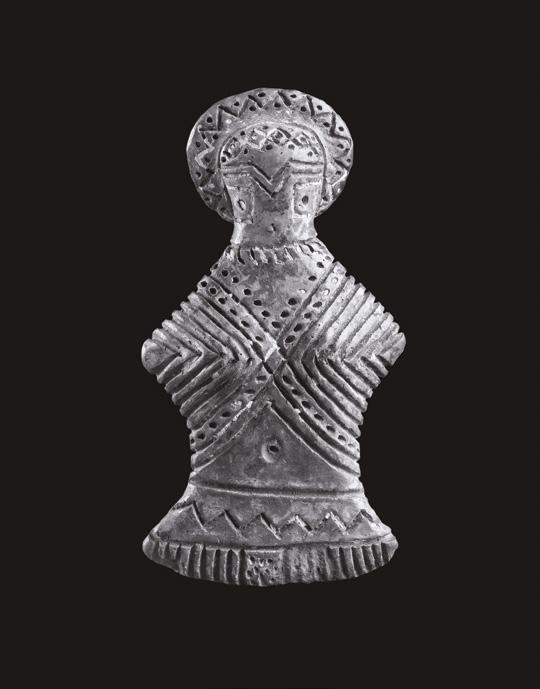
Grundy Art Gallery, Blackpool, Manchester City Galleries, Victoria Gallery & Museum, University of Liverpool, Walker Art Gallery, National Museums Liverpool and Whitworth Art Gallery, The University of Manchester
Helen Marten
Exfoliating curve lines (total cushioning) (2014)
Glazed ceramic, cast rubber, yoghurt pot, cross stitch, fabric, swim caps, fimo, copper wire, sugar shaker, sawdust, saw blade, zip pull, welded steel, sponges, red balloon, black sand, tape measure ribbon
ceramic: 161 x 56 x 46cm
stool: 65 x 40 x 40cm
Helen Marten (b. 1985, Macclesfield, UK) lives and works in London having studied at The Ruskin School of Art, University of Oxford and Central Saint Martins College of Art and Design. Recent solo exhibitions include Sadie Coles, London (2014), CCS Bard Hessel Museum, New York (2013), Chisenhale Gallery, London (2012), Palais de Tokyo, Paris (2012) and Kunsthalle Zürich, Switzerland (2012). Marten also exhibited as part of The Encyclopaedic Palace, 55th International Art Exhibition, Venice Biennale (2013).
Helen Marten uses sculptural assemblage and video to reflect upon the relationship between two and three dimensional form. Exfoliating curve lines (total cushioning) is the first time Marten has produced ceramic work of this scale. The work hints at figuration from one level removed where crassly simplified outlines have been bulbously inflated. The ceramic work serves as a repository for an elaborate sculptural tableaux whose assembled detritus creates a string of hieroglyphs, a kind of archaeological anagram: encrypted sequences present short bursts of personality and internal logic.
The Cathy Wills Sculpture Fund was generously initiated by Contemporary Art Society Trustee Cathy Wills in 2011. The fund enables five museums in the North West of England to develop their collections with contemporary sculpture through co-acquiring works.
Presented by the Contemporary Art Society, 2014, through the Cathy Wills Sculpture Fund
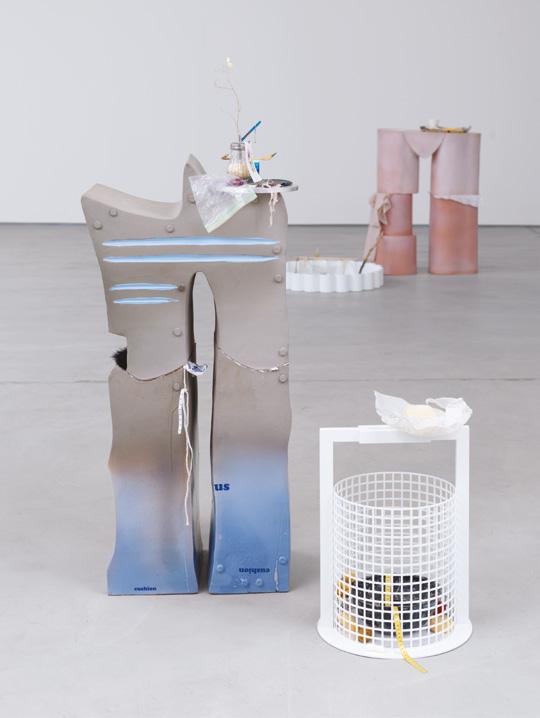
Leeds Art Gallery
Simon Fujiwara
Rebekkah (2012)
Five terra-cotta dyed, life size, cast plaster female figures and video Dimensions variable

Simon Fujiwara (b. 1982, London, UK) lives and works in Berlin. Using a combination of performance, video, installation and short stories, Fujiwara’s work is rooted in dense dramas about personal relationships, family relations, politics, architecture and history. Over the past few years he has had solo exhibitions at Palais de Tokyo, Paris (2014) and Tate St Ives (2012). In 2010, Fujiwara was awarded The Cartier Award at Frieze Art Fair, London.
Rebekkah is a 16 year old girl from Hackney who was one of the protagonists of the London riots in 2011. Instead of facing prosecution, Rebekkah was asked by Simon Fujiwara to travel to China to take part in a unique social experiment. During this time she was given no access to social media and was unable to communicate with her peers, giving her time to reflect on her experiences. While in China Rebekkah visited factories where many of the objects she owns or aspires to own (fashion clothing, mobile phones, flatscreen TVs) are produced and witnessed what can be achieved when a massive-scale, national population pulls together towards one common goal: individual improvement through mass production, organisation and hard work.
The trip culminated with a viewing of the Terracotta Warriors, after which Rebekkah was taken to a factory where casts were made of her body to be assembled into modern day versions of the warriors. Rebekkah feeds into existing narratives within the collection at Leeds Art Gallery and helps to chart the development of life-size figure sculpture and portrait sculpture from the 19th century.
Presented by the Contemporary Art Society Collections Committee, 2013
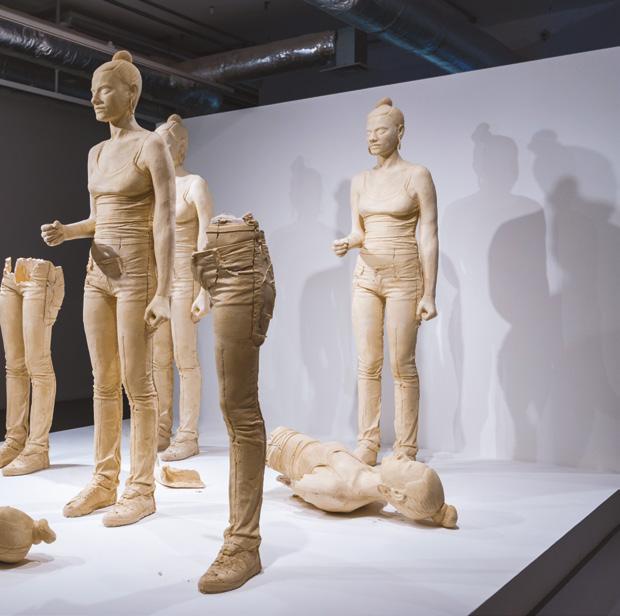
“I would like to thank the Contemporary Art Society for all their support. My career as an artist would not have been possible without public art institutions and has entirely evolved through public support for the arts. The Contemporary Art Society purchased USER GROUP DISCO in 2012, and that was the first purchase of my work for a public collection. This was a very important moment for me. It was a real show of confidence in a new body of work, and it fulfilled one of my ambitions for my work—that they are owned publicly, that they’re owned by us in common.”
Elizabeth Price, ArtistFor over a century the Contemporary Art Society has worked closely with individuals to donate artworks from their collections to public museums and galleries across the UK. The generosity of donors has enabled artworks, which are often beyond the means of the museum, to enter public collections for audiences to enjoy in perpetuity.
Many firsts have entered public collections this way: the first works by Michael Craig-Martin to enter a Scottish collection, the first Karel Appel to enter a museum in Wales, the first Stanley Spencer painting for Tate in 1925 and the first works by Bruce McLean to be represented in a public museum. These have all been the result of the vision of philanthropists.
Working closely with museum curators across the country, and drawing on our own specialist knowledge, the Contemporary Art Society throughout 2012 and 2013 has gifted 34 artworks to 13 different public collections in the UK.
The Contemporary Art Society has continued to gift works from the Eric & Jean Cass Gift throughout 2013. Gifts include sixteen works by Zadok Ben-David to Leamington Spa Art Gallery and Museum, a ceramic figure by Christie Brown to York Art Gallery, a lime wood sculpture by Malcolm Martin & Gaynor Dowling to Plymouth City Museum & Art Gallery, a sculpture by Bryan Kneale to Abbot Hall Art Gallery, Lakeland Arts Trust, a paper work by Pavlos to Bury Art Museum and a Japanese woodblock print by Suzuki Harunobu to Laing Art Gallery. All works have been gratefully received by the participating museums and galleries, and so far to date the Eric & Jean Cass Gift has distributed 134 works to over 20 public museums and galleries.
Pavlos
Chausettes (1989)
Paper
Height 40cm
Bury Art Museum is home to the Wrigley Collection of Art which was donated to the city by the local paper manufacturer Thomas Wrigley in 1897. The collection consists of over two hundred oil paintings, watercolours, prints and ceramics and includes artists
J.M.W Turner, Edwin Henry Landseer, John Constable and George Clausen. Textiles and paper both feature prominently in the collection and there is a current focus on developing a collection of paper-based art that moves away from paper’s traditional artistic function of being a support for the artist. Bury Art Museum’s nascent contemporary paper collection includes works by Anne Teahan, Carol Farrow, Hannah Lobley and Susan Cutts among others.
Pavlos (b. 1930, Filiatra, Greece) studied at The School of Fine Arts in Athens and was originally an abstract painter. In 1954 he received a Greek state scholarship for a three year stay in France, where he was introduced to a group of artists in Paris called the New Realists, from whom he was inspired to shape paper strips into art objects. In the early 1960s, Pavlos began creating finely detailed, still life compositions of machine cut strips of misprinted poster paper.
Donated by Eric and Jean Cass through the Contemporary Art Society, 2012

Since 2002 Patron Dasha Shenkman has gifted 43 artworks to the Contemporary Art Society for donation to museums and galleries. This has included a key painting by Bruce McLean; lithographs by Victor Vasarely, Jean Arp and Frank Auerbach; photographs by Sarah Jones and Georgie Hopton and sculpture by William Tucker and Julian Opie
Works placed this year include a painting by Gillian Ayres to Leeds Art Gallery; a woodcut by Christiane Baumgartner to the Ashmolean Museum of Art and Archaeology, University of Oxford; a print and a painting by Stephen Conroy to The Hunterian Museum and Art Gallery, University of Glasgow and a mixed media work by Hughie O’Donoghue to the Imperial War Museum, London.
Gillian Ayres
Babylon (1984)
Oil on canvas
18 x 18 inches
Since it was established in 1888, Leeds Art Gallery has concentrated on collecting contemporary art, in particular 19th and 20th century British painting as well as a renowned collection of modern British sculpture. Leeds Art Gallery continues to collect contemporary art and recent acquisitions include works by Paula Rego, Bridget Riley, Mark Wallinger, Alison Wilding, Stephen Willats and Bill Woodrow
Gillian Ayres (b. 1930, London, UK) is one of the leading British abstract painters of her generation. She studied at Camberwell School of Art from 1946-50 where she met her future husband Henry Mundy, and established friendships with artists Roger Hilton, Robyn Denny and Howard Hodgkin. As well as the vibrant, heavily worked abstract canvases for which she is best known, Ayres is also a dedicated printmaker. Leeds Art Gallery already own the major work Helios (1990) so were delighted to receive Babylon (1984) to strengthen and enhance their collection in this area.
Ayres had her first solo exhibition at Gallery One, London (1956), and was included in the Whitechapel Gallery’s British Painting exhibition (1965). By the mid-1960s, Ayres began to use acrylic paints to produce works using a limited colour range and simpler forms. From 1979 Ayres was regularly exhibiting in both London and New York and her paintings of this period had become more colourful and were painted in thick oil paint to build textured, impasto surfaces. Ayres has exhibited internationally and held a retrospective exhibition at the Serpentine Gallery, London (1983). Ayres was made an OBE in 1986, nominated for the Turner Prize (1989) and became an RA in 1991. Solo shows have included the Museum of Modern Art, Oxford (1981), Tate Gallery, London (1995) and the Royal Academy of Arts, London (1997).
Gifted by Dasha Shenkman through the Contemporary Art Society, 2013
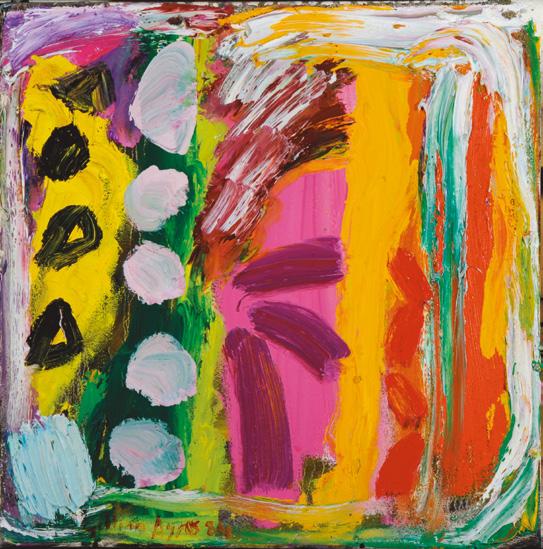
Christiane Baumgartner
Gelande II (2010)
Woodcut on Misumi Japanese paper
37 x 50cm
The Ashmolean Museum of Art and Archeology was built between 1678-1683 to house the cabinet of curiosities that Elias Ashmole gave to Oxford University in 1677, and became the world’s first university museum. The collections at the Ashmolean are extraordinarily diverse, ranging from prehistoric Europe to the present day, and include the world’s largest collection of Raphael drawings, the most important collection of pre-dynastic Egyptian material in Europe and the finest Anglo-Saxon collections outside the British Museum. As well as its historic collections the Ashmolean is also home to a collection of contemporary art with six dedicated galleries. Artists represented include Auguste Renoir, Walter Sickert, Maggi Hambling, Howard Hodgkin, Barbara Hepworth and Lucian Freud. Contemporary artists Antony Gormley, Tracey Emin, David Hockney and Rachel Whiteread are also represented in the print collection.
Christiane Baumgartner (b. 1967, Leipzig, Germany) studied at the Hochschule für Grafik und Buchkunst before completing her masters in printing at the Royal College of Art, London. Baumgartner is best known for her monumental woodcuts based on her own film and video stills. Monochromatic and up to several meters long, Baumgartner works with photo-realist exactitude and deals with the concepts of time, motion, velocity and acceleration. The notion of time is also embodied in her artistic process — the lengthy and painstaking medium of the handmade woodcut. Baumgartner first came to attention in the UK at EAST International (2004) and a year later had a major solo exhibition at Ikon Gallery, Birmingham. Baumgartner’s work is in over 30 public collections worldwide.
Gifted by Dasha Shenkman through the Contemporary Art Society, 2013
Stephen Conroy
Study for 3 bob a week (1987) Oil on Canvas
25.7 x 20.6cm
Stephen Conroy Head Study (1992) Monoprint
30.5 x 22.8cm
The Hunterian Museum and Art Gallery is the oldest public museum in Scotland. It opened to the public in 1807, and has one of the largest collections outside the National Museums. The museum was built on Dr William Hunter’s founding bequest and is now home to the world’s largest permanent display of the work of James McNeil Whistler and also an important collection of work by Charles Rennie Mackintosh
Scottish art is an important part of the Hunterian’s collection and includes paintings by Alan Davie, Joan Eardley and William Gear as well as an extensive collection of Scottish printmaking, in which Stephen Conroy is represented with two works. The Hunterian is also developing an important collection of contemporary art and over recent years new acquisitions have included works by Lucy Skaer, Christine Borland and Mat Collishaw
Stephen Conroy (b. 1964, Helensburgh, UK) is a Scottish figurative painter. He studied at Glasgow School of Art from 1982-1987 and whilst still a student had his work included in The Vigorous Imagination exhibition at the Scottish National Gallery of Modern Art, Edinburgh. Conroy’s work has a recognisable style, noted for his traditional drawing of elusive figures in formal poses in his paintings, etchings and lithographs.
Gifted by Dasha Shenkman through the Contemporary Art Society, 2013

Hughie O’Donoghue
A Monument in Rouen (2003)
Oil on prepared book with inkjet on gampi tissue
36 x 58 x 5cm
The Imperial War Museum’s collection covers all aspects of 20th and 21st century conflict involving Britain, the Commonwealth and other former empire countries in a wide range of material including film, oral history, personal letters, diaries and works of art. Since the collection began it has focused on collecting work created by artists responding to events as they unfold. One significant strand within the contemporary art collection is a growing body of work which reflects how we remember historical conflicts, their repercussions and resonances today.
Hughie O’Donoghue (b. 1953, Manchester, UK) is a British painter whose subjects are based on history, memory and myth. At the heart of his work is the re-imagining of individual lives such as the hardship of itinerant Irish laborers or the experience of his father in the Second World War.
Monument in Rouen is one of a series of works made using prepared books as a base. Using a photograph from the Imperial War Museum’s archives, O’Donoghue has subtly painted and layered the image onto the open book, highlighting the narrative nature of the work. The photograph was taken in 1940 by Captain Keating of an abandoned motorcycle dump at Monce. O’ Donoghue’s father was a motorcycle reconnaissance rider in this part of France at that time and Monument in Rouen reconstructs his experiences as part of the retreating British Expeditionary Force. O’Donoghue is eager to make us aware of the reconstructed nature of these memories, while highlighting the acts of remembering and forgetting. For the Imperial War Museum this is particularly pertinent as we reflect on the shadows cast over today’s world by personal and shared memories of conflict.


Sea Land (1967)
Silkscreen
43.2 x 56.1cm
–Ian Hamilton FinlayCatameringue (1970)
Silkscreen
35.5 x 44.4cm
The Contemporary Art Society is pleased to gift five works by Ian Hamilton Finlay (1925-2006, b. 1925, Nassau, Bahamas) from The David & Liza Brown Bequest to The Pier Arts Centre, Stromness, Orkney.
As well as being a curator and veterinary surgeon, David Brown was a prolific collector of 20th century art and bequeathed many works from his collection to a small number of public institutions including Tate, the Scottish National Gallery of Modern Art, the British Museum and Southampton City Art Gallery whose own collection he helped to form. David and Liza Brown’s diverse collection included figure studies and landscapes together with language based works by Ian Hamilton Finlay and also a number of works by unfamiliar artists from the early 20th century.
After studying art history at the University of East Anglia in 1970, Brown took a post at the Scottish National Gallery of Modern Art and curated exhibitions of work by Duncan Grant, Roger Hilton and Richard Long. In 1974 after fourteen months in Edinburgh, Brown moved to London where he was appointed Assistant Curator in the Modern Collection at Tate Gallery. He curated many exhibitions during his time at Tate including a major St Ives exhibition in 1985.
The Contemporary Art Society was pleased to be able to assist in distributing works from The David & Liza Brown Bequest, and in 2013 have gifted five prints by Ian Hamilton Finlay to The Pier Arts Centre. Hamilton Finlay’s association with Orkney dates back to the 1950s and Pier Arts Centre has steadily built up a collection of early print works by the artist. The five prints are a great addition to the collection and will allow for a concentrated display of the artist’s early poetic works as well as offering opportunities to present Hamilton Finlay’s work in a broader Scottish context.
Given by David and Liza Brown through the Contemporary Art Society, 2014

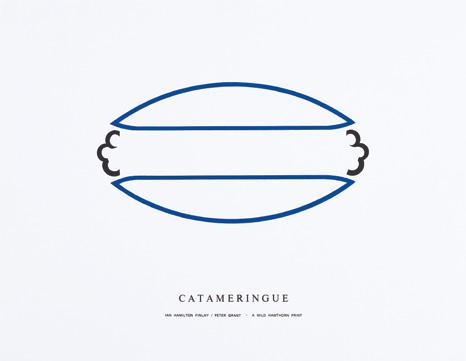
Yinka Shonibare
Untitled (Dollhouse) (2002)
Wax-print cloth, various wood
27.9 x 20.3 x 23.4cm
Limited edition
Yinka Shonibare (b. 1962, London, UK) Untitled (Dollhouse) was originally commissioned as part of the Peter Norton Christmas Art Project. Every year since 1988, art collector and software entrepreneur Peter Norton has commissioned an edition to celebrate the holidays. Created by artists who are in Norton’s own personal collection, the editions are sent as gifts to friends and members of the art community.
The Contemporary Art Society was pleased to have the opportunity to gift Untitled (Dollhouse) to the Walker Art Gallery, National Museums Liverpool. The Walker Art Gallery is working to strengthen their holdings of contemporary sculpture and Shonibare’s explorations of global issues including colonialism, race, and class have resonance across National Museums Liverpool’s collections. As well as links to the gallery’s historic fine art collections, the Walker Art Gallery also has a collection of 19th century dolls houses drawing links to their decorative art holdings.
The dolls house is an exact replica of the 1872 Victorian town house in the East End of London where Shonibare lives and, as in many of his other works, Dutch wax-print cloth covers miniature furniture in the house. The two-storey house includes miniature cabinets, chairs, tables, fireplaces and a bed, along with reproductions of paintings by Shonibare and Jean-Honore Fragonard
Gifted by an anonymous donor through the Contemporary Art Society, 2013
Billy Apple
Self Portraits (Apple Sees Red on Green) (1962) Offset lithograph on canvas 102 x 77cm
The Contemporary Art Society is delighted to gift Billy Apple (b. 1935, Auckland, New Zealand) Self Portraits (Apple Sees Red on Green) (1962) to Tate. Born Barrie Bates in New Zealand in 1935, Apple moved to the UK in 1959 and enrolled at the Royal College of Art (RCA). During his time at the RCA, Apple met several artists, including Allen Jones and David Hockney, who went on to become a new generation of pop artists. Upon graduating in 1962, Bates changed his name, bleached his hair, and reinvented himself as the artistic brand Billy Apple.
Apple’s work Self Portraits (Apple Sees Red on Green) was exhibited in Apple’s first solo show, Apple Sees Red: Live Stills at Gallery One, London (1963). The work exemplifies Apple’s individual manifestation of Pop Art that drew on the language of advertising to convey his own rebranding. Apple was blurring the distinctions between art and life, as much as people and products or commodities. The work is from a series of 12 near-identical canvases that incorporate colour photographs of Apple that had been taken by Robert Freeman. With this work Apple portrays himself as mug-shot, pin-up and product — heralding a new commodity brand straight off the production line. This was one of a number of works conveying his re-invented self-identity, the new Billy Apple brand that was included in the same exhibition.
Presented by the Contemporary Art Society, 2013
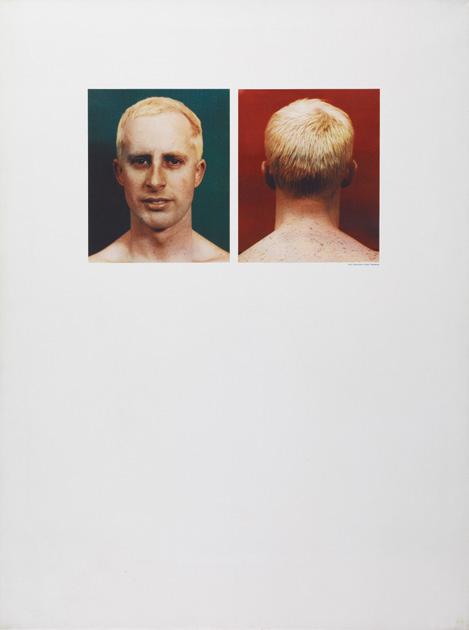
“Following a studio visit the Contemporary Art Society recently acquired my painting Concrete Ball for Southhampton City Art Gallery. It is a huge honour and privilege for me to be part of this wonderful public collection.”
Phoebe Unwin, Artist
This has been a fruitful time for the Contemporary Art Society’s Consultancy team, extending our work in creating visionary public art strategies, commissioning new artworks and building contemporary art collections.
Our public art programme for the University of Cambridge saw the first Artists in Residence Tania Kovats, Hannah Rickards and Nina Pope & Karen Guthrie occupy refurbished cottages on the North West Cambridge development site and commence research collaborations within academic departments. Major new commissions are also being developed for the development by Winter & Hoerbelt, AK Dolven and Ruth Proctor. In London we were appointed to manage the commissioning process for a new art work in Dulwich Park, after the tragic theft of the Barbara Hepworth sculpture in 2011. We supported Southwark council in the final selection of Conrad Shawcross to create a new permanent work for the park which will be installed in late 2014. We are also commissioning works by Nicky Hirst and James Ireland for the Kingsley Green Mental Health Unit as part of the art strategy we prepared for the Hertfordshire Partnership NHS Foundation Trust. Other public work planned includes an art strategy for the University of Leeds and commission for their library by Simon Fujiwara, a national strategy for Qatar’s public realm and a new commission by Mark Wallinger for the O’Donnell + Tuomey designed student centre at the London School of Economics.
Our work with corporate clients has also flourished. We curated a bespoke new art collection for the offices of Inflexion Private Equity in Mayfair, including works by Phillip Allen, Lothar Götz, Lisa Oppenheim, Michael Conrads and Alison Turnbull. For Glebe Asset Management’s fabulous apartment development in Albemarle St we built an impressive contemporary art collection to complement the beautiful Eric Parry interior design. Following on from our work with Clare Woods on the Olympic Park, we secured one of her large-scale paintings for the foyer of Eagle Place in Central London for developers Stanhope PLC and The Crown Estate. At ArtHouse, the first residential building at Argent PLC’s rapidly evolving King’s Cross development, we commissioned artist Robert Orchardson to develop two sculptures for the reception areas. Our longstanding management of Aspen’s global art collection expanded with the purchase of a new selection of works for the company’s Zurich office featuring important emerging Swiss artists and the development of an award for university graduates to commission a new, online artwork for the Aspen website.

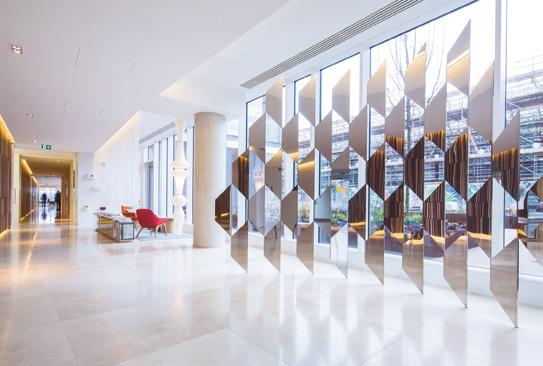
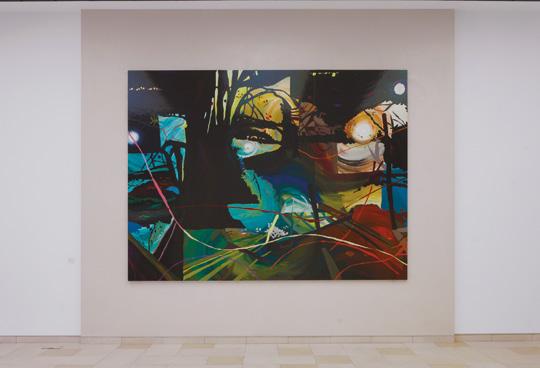
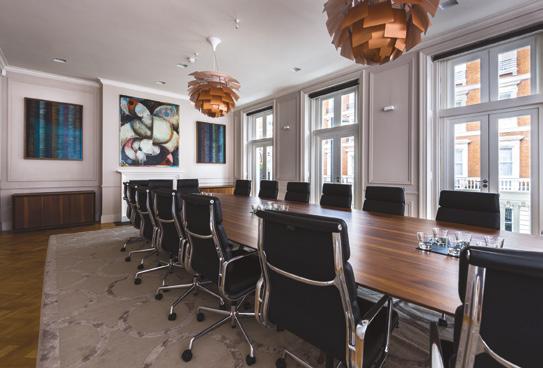
Acquisitions Scheme: Fine Art
Atkins, Ed, The Trick Brain (2012-13)
Beasley, Becky, Figure (Part 3) (2008)
Scottish National Gallery of Modern Art, Edinburgh, p.48
Leeds Art Gallery, p.30
Cruz, Angela de la, One Painting (1999) Tate, p.54
Dobai, Sarah, Twenty Second Hold (2012)
Ewan, Ruth, Nae Sums 1911 (2011)
Dreadnoughts (2010)
Bristol Museum and Art Gallery, p.18
The McManus, Dundee’s Art Gallery and Museum, p.34
Birmingham Museums and Art Gallery, p.14 London Oyster Shells (2012)
Flood-Paddock, Jess, Snacks 4 (2011)
Hefti, Raphael, Disco No. 7 (2006)
Hughes, Des, In a Brown Study (2011)
Kane, Alan, Home-works 1 (2014)
Home-works 2 (2014)
Abbot Hall Art Gallery, Lakeland Arts Trust, Cumbria, p.10
Manchester City Galleries, p.32
The Collection and Usher Gallery, Lincoln, p.22
Keen, Jeff, O Here Comes The Seafaring Brighton Museum & Art Gallery, p.16 Man (1950)
Lancaster, Laura, Untitled (2013)
Untitled (2013)
Untitled (2013)
Løw, Camilla, Cinematic (2014)
Luxemburg, Rut Blees, The Kiss (2003)
Maclean, Rachel, The Lion and the
The New Art Gallery, Walsall, p.40
Pier Arts Centre, Stromness, Orkney, p.42
Glynn Vivian Art Gallery, Swansea, p.26
Aberdeen Art Gallery & Museums, p.12 Unicorn (2012)
The Massacre (2013)
Highland Romance (2013)
St George and the Monster (2013)
The Baptism of Clyde (2013)
Margolles, Teresa, Papeles de la mima, Middlesbrough Institute of Modern Art, p.38 morgue [#9] (2003)
McAlpine, Elizabeth, Ends (Sprayed Rugby Art Gallery & Museum, p.46 Sound) (2013)
Opie, Catherine, The Gang (1990)
Orlow, Uriel, The Short and the Long
Walker Art Gallery, National Museums
Liverpool, p.60
Towner, Eastbourne, p.56 of It (2010-12)
Pickstone, Sarah, KM’s Moth (Red
Mercer Art Gallery, Harrogate, p.36 Underwing) (2014)
Study for Sylvia (2010)
Plath Winged x 2 (2010)
Study for Stevie Smith and the Willow (2011)
Quaife, Magnus, Untitled (Ben) (2010)
Untitled (Miss Iceland) (2010)
Untitled (Prague Tank) (2010)
Swindon Museum and Art Gallery, p.52
Qureshi, Imran, This Leprous Gallery Oldham, p.24 Brightness (2011)
Sansour, Larissa, Nation Estate (2012)
Shrigley, David, Untitled (2009)
Imperial War Museum, London and Wolverhampton Art Gallery, p.28
Cartwright Hall Art Gallery, Bradford Museums
Untitled (2009) and Galleries, p.20
Untitled (2010)
Unwin, Phoebe, Concrete Ball (2012)
Woods, Clare, Obscene Porridge (2012)
Yiadom-Boakye, Lynette, To Tell Them
Southampton City Art Gallery, p.50
Tullie House Museum & Art Gallery, Carlisle, p.58
Plymouth City Museum & Art Gallery, p.44 Where It’s Got To (2013)
Acquisitions Scheme: Craft
Counsell, Alison, Wapenmap: Damflask, Graves Gallery, Museums Sheffield, p.68 Agden, Dale Dike & Strines (2004)
Jerram, Luke, Glass Microbiology H1N1 The Collection and Usher Gallery, Lincoln, p.66 Swine Flu (2011)
Liao, Chun, For You (2012)
Aberdeen Art Gallery & Museums, Cheltenham Art Gallery & Museum, mima, Middlesbrough Institute of Modern Art, p.64
Malet, Claire, Ridged Vessel (2014)
Manchester City Galleries, p.70
Laric, Oliver, Lincoln 3D Scans The Collection and Usher Gallery, Lincoln, p.74
Price, Elizabeth
Ashmolean Museum of Art and Archaeology, University of Oxford (in partnership with the Pitt Rivers Museum and the Ruskin School of Art), p.76
Strategic Initiatives: Cathy Wills Sculpture Fund
Marten, Helen, Exfoliating curve lines
Grundy Art Gallery, Blackpool, Manchester (total cushioning) (2014) City Galleries, Victoria Gallery & Museum, University of Liverpool, Walker Art Gallery, National Museums Liverpool and Whitworth Art Gallery, The University of Manchester, p.78
Strategic Initiatives: Collections Committee
Fujiwara, Simon, Rebekkah (2012) Leeds Art Gallery, p.80
Gifts and Bequests: Eric and Jean Cass
Ben-David, Zadok, Circle of Life: The Leamington Spa Art Gallery and Museum, p.84 Mystical Experience of the Wild Cat (1986)
Happiness is Not Where Your Seek It (1987)
Where it all starts (1993)
Conversation Piece (1993)
The Broken Expectation (1993)
Come and Get Me (1993)
Opinions (1993)
Fear of Flying (1993)
Big Science (No. 19) (1994-5)
Antarctica (1994-5)
Big Science (The Magic Book) (1998)
Thermometer (1998)
Study for Evolution and Theory
Installation (Neanderthal) (1998)
Study for Evolution and Theory (Small walking Ape) (1998)
Study for Evolution and Theory (Walking Ape) (1998)
Horse (2001)
Brown, Christie, Black River God (1990) York Art Gallery, York Museums Trust, p.84
Harunobu, Suzuki, The Plover Jewel Laing Art Gallery, Newscastle-upon-Tyne, p.84 River: A Famous Place in Mutsu
Province (Chidori no Tamagawa, Mutsu no meisho) from the series Elegant
Customs: Six Jewel Rivers’ (Fuzoku Mu-Tamagawa) (1725-70)
Kneale, Bryan, Ship of Fools (2000)
Abbot Hall Art Gallery, Lakeland Arts Trust, Cumbria, p.84
Martin, Malcolm & Dowling, Gaynor, Plymouth City Museum & Art Gallery, p.84 Cubist Bottle (2002)
Pavlos, Chausettes (1989) Bury Art Museum, p.84
Dasha Shenkman
Ayres, Gillian, Babylon (1984) Leeds Art Gallery, p.86
Baumgartner, Christiane, Gelande II
Ashmolean Museum of Art and Archaeology, (2010) University of Oxford, p.88
Conroy, Stephen, Study for 3 bob a The Hunterian Museum and Art Gallery, week (1987) University of Glasgow, p.88
Head Study (1992)
O’Donoghue, Hughie, A Monument in Imperial War Museum, London, p.90 Rouen (2003)
David and Liza Brown
Finlay, Ian Hamilton, Acrobats (1966) Pier Arts Centre, Stromness, Orkney, p.92
Sea Land (1967)
Catameringue (1970)
Homage to Mozart (1970)
Homage to Malevic (1974)
Anonymous Donors
Apple, Billy, Self Portraits (Apple Sees Tate, p.94 Red on Green) (1962)
Shonibare, Yinka, Untitled (Dollhouse) Walker Art Gallery, National Museums (2002) Liverpool, p.94
Funders
Arts Council England
The Art Fund
Boucheron UK Limited
Cathy Wills Sculpture Fund
Garfield Weston Foundation
Goldlake Group
The John Ellerman Foundation
Lavazza Lexington Partners
Oliver Wyman
Sfumato Foundation
Sotheby’s
Vue Entertainment
Collections Committee
Cathy Wills (Chair)
Hugo Brown
Loraine da Costa
Donall Curtin
Chris Jermyn
Francoise Sarre Rapp
Paul Smith
Audrey Wallrock
Michael Webber
Collections Patrons
Diane Abela
Marie Elena Angulo & Henry Zarb
Heidi Baravalle
Elizabeth Bauza
Robert Bensoussan
Anette Bollag-Rothschild
Michael & Philippa Bradley
Hugo Brown
Simone Brych-Nourry
Bertrand Coste
Laurence Coste
Loraine da Costa
Donall Curtin
Sophie Diedrichs-Cox
Valentina Drouin
Sarah Elson
Antje & Andrew Géczy
David & Susan Gilbert
Kira Heuer
Helen Janecek
Chris Jermyn
Linda Keyte
Paula Lent
Yves & Martina Klemmer
Keith Morris & Catherine
Mason
Suling Mead
Alexandra Nash
Flavia Nespatti
Simon & Midge Palley
Veronique Parke
Daniele Pescali
Mark Renton
Susan Rosenberg
Francoise Sarre Rapp
Dasha Shenkman
Brian Smith
Paul Smith
Glenn & Gaby Unterhalter
Audrey Wallrock
Michael Webber
Cathy Wills
Edwin & Dina Wulfsohn
Anna Yang & Joseph Schull
Andrzej & Jill Zarzycki
Centenary Patrons
Nicola Blake
Alla & Bill Broeksmit
Jeffrey Boone
Paul & Gisele Caseiras
Wolf & Carol Cesman
Susie Cochin de Billy
Daniela Colaiacovo
Tommaso Corvi-Mora
Theo Danjuma
Jonathan & Jacqueline
Gestetner
Karina el Helou
Marcelle Joseph
Michael & Fiona King
Audrey Klein
Anna Lapshina
Zach & Julia Leonard
Joanna Mackiewicz-Gemes
Amber Mahood
Paul McKeown
Frederique Pierre Pierre
Mariela Pissioti
Will Ramsay
Karsten Schubert
Ellen & Dan Shapiro
Henrietta Shields
Karen Smith
Dr Richard Sykes & Penny Mason
Salavat Timiryasov
Susie Tinsley
Honorary Patrons
Tiqui Atencio
Nicholas Berwin
Eric & Jean Cass
Frank Cohen
Denise Esfandi
James Hughes-Hallett
Marie-Rose Kahane
Costas Kaplanis
Fatima & Eskandar Maleki
Elizabeth Meyer
Alison Myners
Valeria Napoleone
Simon Turner
Nicky Wilson
Anita Zabludowicz
And others who wish to remain anonymous
Museum Members
Abbot Hall Art Gallery, Lakeland Arts Trust, Cumbria
Aberdeen Art Gallery & Museums
Ashmolean Museum of Art and Archaeology, University of Oxford
Birmingham Museums and Art Gallery
Brighton Museum & Art Gallery
Bristol Museum and Art Gallery
Bury Art Museum
Cartwright Hall Art Gallery,
Bradford Museums & Galleries
Cheltenham Art Gallery & Museum
The Collection and Usher Gallery, Lincoln
Ferens Art Gallery, Hull
Gallery of Modern Art (GoMA), Glasgow
Gallery Oldham
Glynn Vivian Art Gallery, Swansea
Graves Gallery, Museums
Sheffield
Grundy Art Gallery, Blackpool
Harris Museum and Art Gallery, Preston
The Hepworth Wakefield
Herbert Art Gallery & Museum, Coventry
Huddersfield Art Gallery
The Hunterian Museum and Art Gallery, University of Glasgow
Imperial War Museum, London
Laing Art Gallery, Newcastle-upon-Tyne
Leamington Spa Art Gallery & Museum
Leeds Art Gallery
Manchester City Galleries
Mead Gallery, University of Warwick Art Collection
The McManus, Dundee’s Art Gallery & Museum
Mercer Art Gallery, Harrogate
mima, Middlesbrough
Institute of Modern Art
National Museum Wales, Cardiff
The New Art Gallery Walsall
New Walk Museum & Art
Gallery, Leicester
Norwich Castle Museum & Art Gallery
Nottingham Castle Museum & Art Gallery
Paisley Museum & Art Galleries
Peter Scott Gallery, Lancaster Institute for the Contemporary Arts
The Pier Arts Centre, Stromness, Orkney
Plymouth City Museum & Art Gallery
The Potteries Museum & Art Gallery, Stoke-on-Trent
Rugby Art Gallery & Museum
Scottish National Gallery of Modern Art, Edinburgh
The Shipley Art Gallery, Gateshead
South London Gallery
Southampton City Art Gallery
The Stanley & Audrey Burton Gallery, University Library, Leeds
Sunderland Museum & Winter Gardens
Swindon Museum and Art Gallery
Tate
Touchstones Rochdale, Link4Life
Towner, Eastbourne
Tullie House Museum & Art Gallery, Carlisle
UH Galleries, University of Hertfordshire
Victoria Gallery & Museum, University of Liverpool
Walker Art Gallery, National Museums Liverpool
Whitworth Art Gallery, The University of Manchester
Williamson Art Gallery & Museum, Birkenhead
Wolverhampton Art Gallery
Worcester City Art Gallery
& Museum
York Art Gallery, York Museums Trust
Yorkshire Sculpture Park
Art Consultancy Clients
AECOM/Ashghal, Qatar Aspen
Glebe Asset Management Ltd
Greater London Authority
Hertfordshire Partnership
NHS Foundation Trust
Inflexion Private Equity Partners LLP
King’s Cross Central Limited Partnership
London School of Economics
Lyric Hammersmith
Nuffield College, University of Oxford
Pictet
Southwark Council
Stanhope PLC / The Crown Estate
University of Cambridge
University of Leeds
Mark Stephens CBE (Chair)
Javid Cante
Tommaso Corvi-Mora
Sarah Elson
Antje Géczy
David Gilbert
Zach Leonard
Keith Morris
Cathy Wills
Edwin Wulfsohn
Staff
Caroline Douglas Director
Sophia Bardsley Deputy Director
Curatorial
Christine Takengny Museum Acquisitions & Public Programmes Manager
Ellen Mara De Wachter Curator, Public Collection Development
Robert Dingle National Network & Strategic Projects Manager
Victoria Avery Gifts & Bequests Manager
Kay Watson Public Collection Development Trainee
Lucy Bayley Whitechapel Displays Curator
Development & External Relations
Dida Tait Head of Development & External Relations
Miriam Metliss Patrons & VIP Relations Manager
Sarah Page Membership Programmes Manager
Will Davis Development Trainee
Mark Doyle Head of Collector Development, Contemporary Art Society North
Matthew Hearn Collector Development Manager, North East
Moira Innes Collector Development Manager, Yorkshire
Jenny Prytherch Communications Manager
Grace O’Connor Communications Trainee
Art Consultancy
Fabienne Nicholas Head of Art Consultancy
Helen Nisbet Art Consultancy Project Manager
Jordan Kaplan Art Consultancy Project Manager
Kelly Tsipni-Kolaza Art Consultancy Trainee
Jeni Walwin Art Consultancy Curator
Administration
Phil Ashcroft Office & Projects Manager
Frances Hetherington Accounts Administrator
Kate Moirali Accounts Assistant
Front cover and p.11 © the artist. Courtesy Ancient & Modern, London
p.13 © the artist
p.15 © the artist. Courtesy of Carl Freedman Gallery, London
p.17 © Jeff Keen Estate. Courtesy Kate MacGarry
p.19 Image courtesy Sarah Dobai and WORKS|PROJECTS
p.21 © the artist. Images courtesy Stephen Friedman Gallery
p.23 Alan Kane, Study for plinth (Home-works —1 & 2) (2013) Garden sculptures, bricks, mortar, concrete, steel and household paint, 230 x 60 x 60 cm © the artist
p.25 © the artist. Courtesy the artist and Corvi-Mora Gallery
p.27 © the artist
p.28 © the artist
p.30 © the artist. Courtesy Leeds Art Gallery, Leeds, and Laura Bartlett Gallery, London
p.33 © the artist. Image: Ancient & Modern, London (Art Cologne 2011)
p.35 © the artist. Courtesy the artist and Rob Tufnell
p.37 © the artist
p.39 Courtesy the artist and Galerie Peter Kilchmann, Zurich
p.41 © the artist
p.43 © the artist. Photo Will Bradley
p.45 © the artist. Courtesy Corvi-Mora, London and Jack Shainman Gallery, New York. Photo Marcus Leith, London
p.47 © the artist. Courtesy Laura Bartlett Gallery, London
p.49 © the artist. Courtesy the artist and Cabinet, London
p.51 © the artist. Courtesy the artist and Wilkinson Gallery
p.53 Images courtesy Magnus Quaife and WORKS|PROJECTS
p.55 © the artist. Courtesy the artist and Lisson Gallery
p.57 Uriel Orlow, The Short and the Long of It, 2010-12, installation view, Charles H. Scott Gallery, Vancouver, 2012. Photo Scott Massey © the artist
p.57 Uriel Orlow, The Short and the Long of It, 2010-12, installation view, Palais de Tokyo, Paris, 2013. Photo Aurélien Mole © the artist
p.57 Uriel Orlow, Yellow Limbo, 2010, HD video with sound, 13 minutes, from The Short and the Long of It, 2010-12 © the artist
p.59 © the artist. Courtesy the artist and Stuart Shave Modern Art
p.61 © Catherine Opie. Courtesy Stephen Friedman Gallery and Walker Art Gallery, Liverpool Museums
p.65 photo © Philip Sayer, courtesy of Marsden Woo Gallery, London
p.67 Photo Luke Jerram
p.69 © the artist
p.71 Photo Anthony Evans
p.75 Lincoln 3D Scans, 2013
p.77 AN1910.669 Female figurine with white filled incised decoration © Ashmolean Museum, University of Oxford
p.79 © the artist, courtesy Sadie Coles HQ, London. Photo Annik Wetter, Zurich
p.80 Installation view at Contemporary Art Society. Photo Joe Plommer
p.85 © the artist. Photo Doug Atfield
p.87 © the artist. Courtesy the artist and Leeds Art Gallery
p.89 WA2014.25 © DACS 2014. Image courtesy of Ashmolean Museum, University of Oxford
p.90 Copyright the artists, courtesy of Marlborough Fine Art, London
p.93 Images courtesy Ingleby Gallery, Edinburgh. Photo John McKenzie
p.95 © the artist. Courtesy the artist and The Mayor Gallery
p.98 Collection for the Albemarle Street development by Glebe Artworks. Artists: Richard Woods & Mark Francis. Image courtesy ICO design/ Eric Parry Architects
p.98 Robert Orchardson, Locus at ArtHouse, Kings Cross Central, 2014. Image courtesy John Thurrock
p.99 View of Inflexion board room including Phillip Allen, Starcart (2010) and Lothar Götz, untitled drawings (2013). Image courtesy Joe Plommer
p.99 Eagle Place, Installation of Clare Woods, Difficult Field (2009). Image courtesy Will Pryce
“The Contemporary Art Society was able to put my work into national museums across the country and, as an artist, that’s really where you want your art to be. It’s how to keep your art alive—it’s where it will survive.”
Gavin Turk, Artist